Business Strategy Assignment Sample: Marks & Spencer
VerifiedAdded on 2021/01/01
|16
|5724
|446
AI Summary
Contribute Materials
Your contribution can guide someone’s learning journey. Share your
documents today.
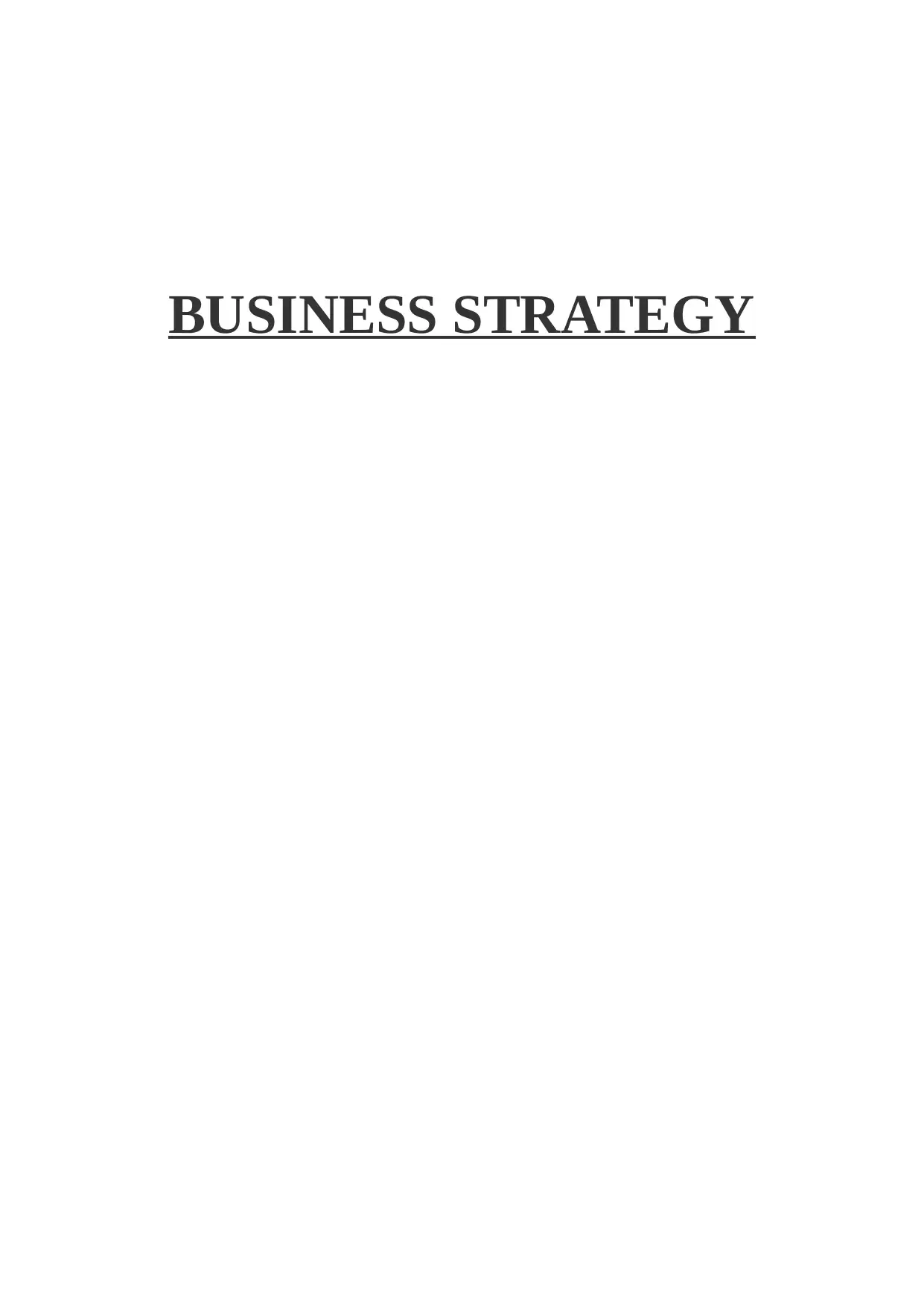
BUSINESS STRATEGY
Secure Best Marks with AI Grader
Need help grading? Try our AI Grader for instant feedback on your assignments.
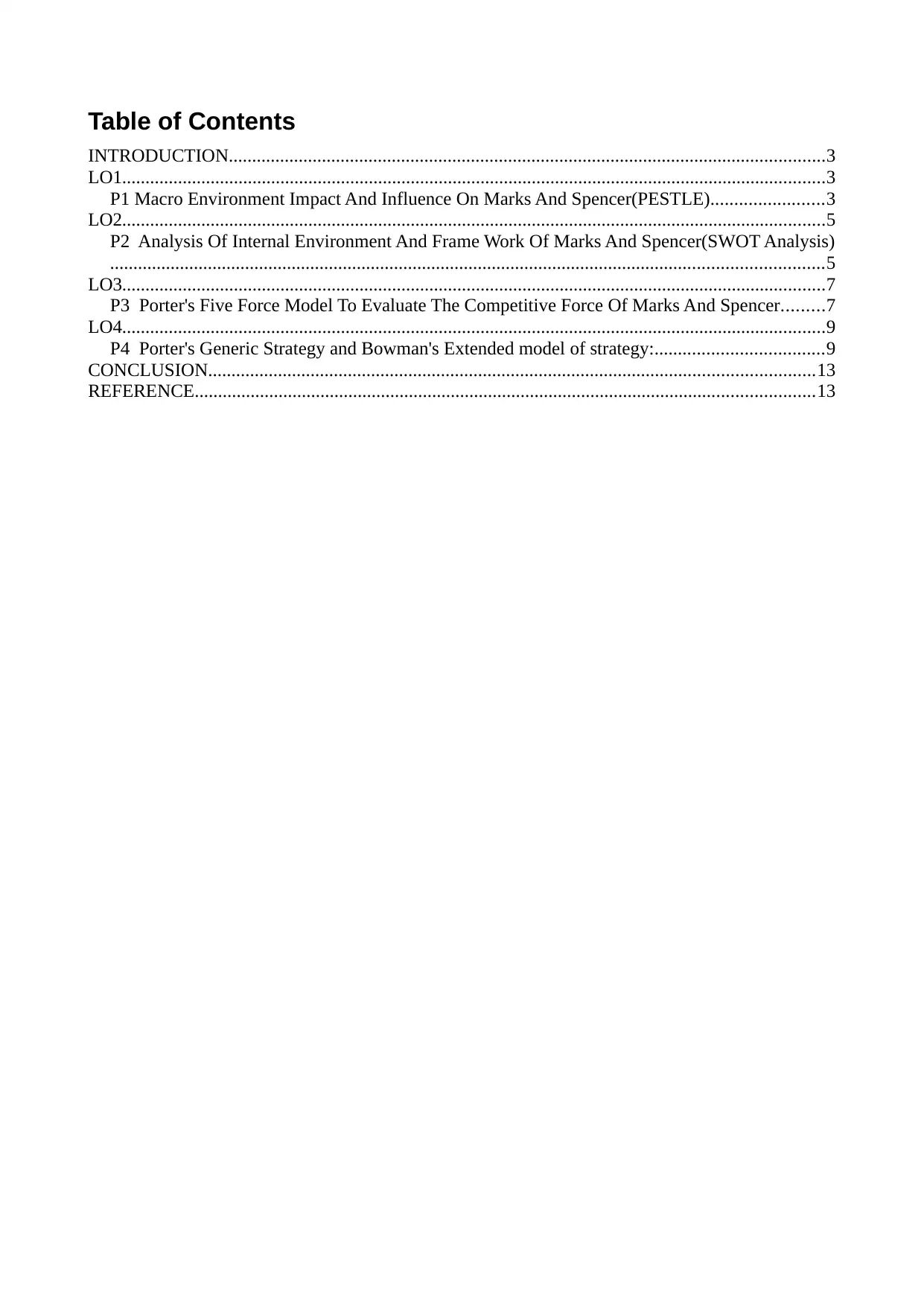
Table of Contents
INTRODUCTION................................................................................................................................3
LO1.......................................................................................................................................................3
P1 Macro Environment Impact And Influence On Marks And Spencer(PESTLE)........................3
LO2.......................................................................................................................................................5
P2 Analysis Of Internal Environment And Frame Work Of Marks And Spencer(SWOT Analysis)
.........................................................................................................................................................5
LO3.......................................................................................................................................................7
P3 Porter's Five Force Model To Evaluate The Competitive Force Of Marks And Spencer.........7
LO4.......................................................................................................................................................9
P4 Porter's Generic Strategy and Bowman's Extended model of strategy:....................................9
CONCLUSION..................................................................................................................................13
REFERENCE.....................................................................................................................................13
INTRODUCTION................................................................................................................................3
LO1.......................................................................................................................................................3
P1 Macro Environment Impact And Influence On Marks And Spencer(PESTLE)........................3
LO2.......................................................................................................................................................5
P2 Analysis Of Internal Environment And Frame Work Of Marks And Spencer(SWOT Analysis)
.........................................................................................................................................................5
LO3.......................................................................................................................................................7
P3 Porter's Five Force Model To Evaluate The Competitive Force Of Marks And Spencer.........7
LO4.......................................................................................................................................................9
P4 Porter's Generic Strategy and Bowman's Extended model of strategy:....................................9
CONCLUSION..................................................................................................................................13
REFERENCE.....................................................................................................................................13
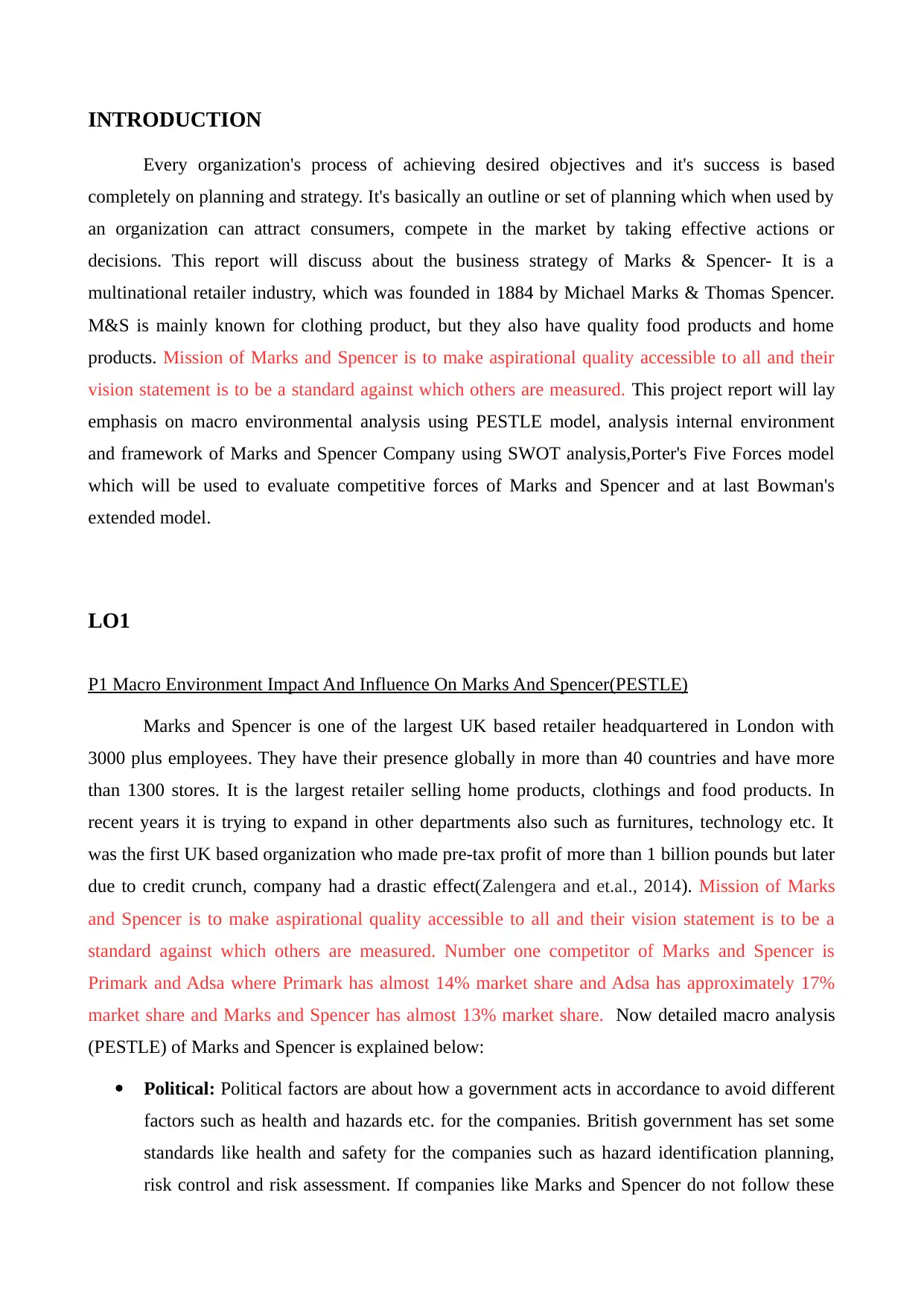
INTRODUCTION
Every organization's process of achieving desired objectives and it's success is based
completely on planning and strategy. It's basically an outline or set of planning which when used by
an organization can attract consumers, compete in the market by taking effective actions or
decisions. This report will discuss about the business strategy of Marks & Spencer- It is a
multinational retailer industry, which was founded in 1884 by Michael Marks & Thomas Spencer.
M&S is mainly known for clothing product, but they also have quality food products and home
products. Mission of Marks and Spencer is to make aspirational quality accessible to all and their
vision statement is to be a standard against which others are measured. This project report will lay
emphasis on macro environmental analysis using PESTLE model, analysis internal environment
and framework of Marks and Spencer Company using SWOT analysis,Porter's Five Forces model
which will be used to evaluate competitive forces of Marks and Spencer and at last Bowman's
extended model.
LO1
P1 Macro Environment Impact And Influence On Marks And Spencer(PESTLE)
Marks and Spencer is one of the largest UK based retailer headquartered in London with
3000 plus employees. They have their presence globally in more than 40 countries and have more
than 1300 stores. It is the largest retailer selling home products, clothings and food products. In
recent years it is trying to expand in other departments also such as furnitures, technology etc. It
was the first UK based organization who made pre-tax profit of more than 1 billion pounds but later
due to credit crunch, company had a drastic effect(Zalengera and et.al., 2014). Mission of Marks
and Spencer is to make aspirational quality accessible to all and their vision statement is to be a
standard against which others are measured. Number one competitor of Marks and Spencer is
Primark and Adsa where Primark has almost 14% market share and Adsa has approximately 17%
market share and Marks and Spencer has almost 13% market share. Now detailed macro analysis
(PESTLE) of Marks and Spencer is explained below:
Political: Political factors are about how a government acts in accordance to avoid different
factors such as health and hazards etc. for the companies. British government has set some
standards like health and safety for the companies such as hazard identification planning,
risk control and risk assessment. If companies like Marks and Spencer do not follow these
Every organization's process of achieving desired objectives and it's success is based
completely on planning and strategy. It's basically an outline or set of planning which when used by
an organization can attract consumers, compete in the market by taking effective actions or
decisions. This report will discuss about the business strategy of Marks & Spencer- It is a
multinational retailer industry, which was founded in 1884 by Michael Marks & Thomas Spencer.
M&S is mainly known for clothing product, but they also have quality food products and home
products. Mission of Marks and Spencer is to make aspirational quality accessible to all and their
vision statement is to be a standard against which others are measured. This project report will lay
emphasis on macro environmental analysis using PESTLE model, analysis internal environment
and framework of Marks and Spencer Company using SWOT analysis,Porter's Five Forces model
which will be used to evaluate competitive forces of Marks and Spencer and at last Bowman's
extended model.
LO1
P1 Macro Environment Impact And Influence On Marks And Spencer(PESTLE)
Marks and Spencer is one of the largest UK based retailer headquartered in London with
3000 plus employees. They have their presence globally in more than 40 countries and have more
than 1300 stores. It is the largest retailer selling home products, clothings and food products. In
recent years it is trying to expand in other departments also such as furnitures, technology etc. It
was the first UK based organization who made pre-tax profit of more than 1 billion pounds but later
due to credit crunch, company had a drastic effect(Zalengera and et.al., 2014). Mission of Marks
and Spencer is to make aspirational quality accessible to all and their vision statement is to be a
standard against which others are measured. Number one competitor of Marks and Spencer is
Primark and Adsa where Primark has almost 14% market share and Adsa has approximately 17%
market share and Marks and Spencer has almost 13% market share. Now detailed macro analysis
(PESTLE) of Marks and Spencer is explained below:
Political: Political factors are about how a government acts in accordance to avoid different
factors such as health and hazards etc. for the companies. British government has set some
standards like health and safety for the companies such as hazard identification planning,
risk control and risk assessment. If companies like Marks and Spencer do not follow these
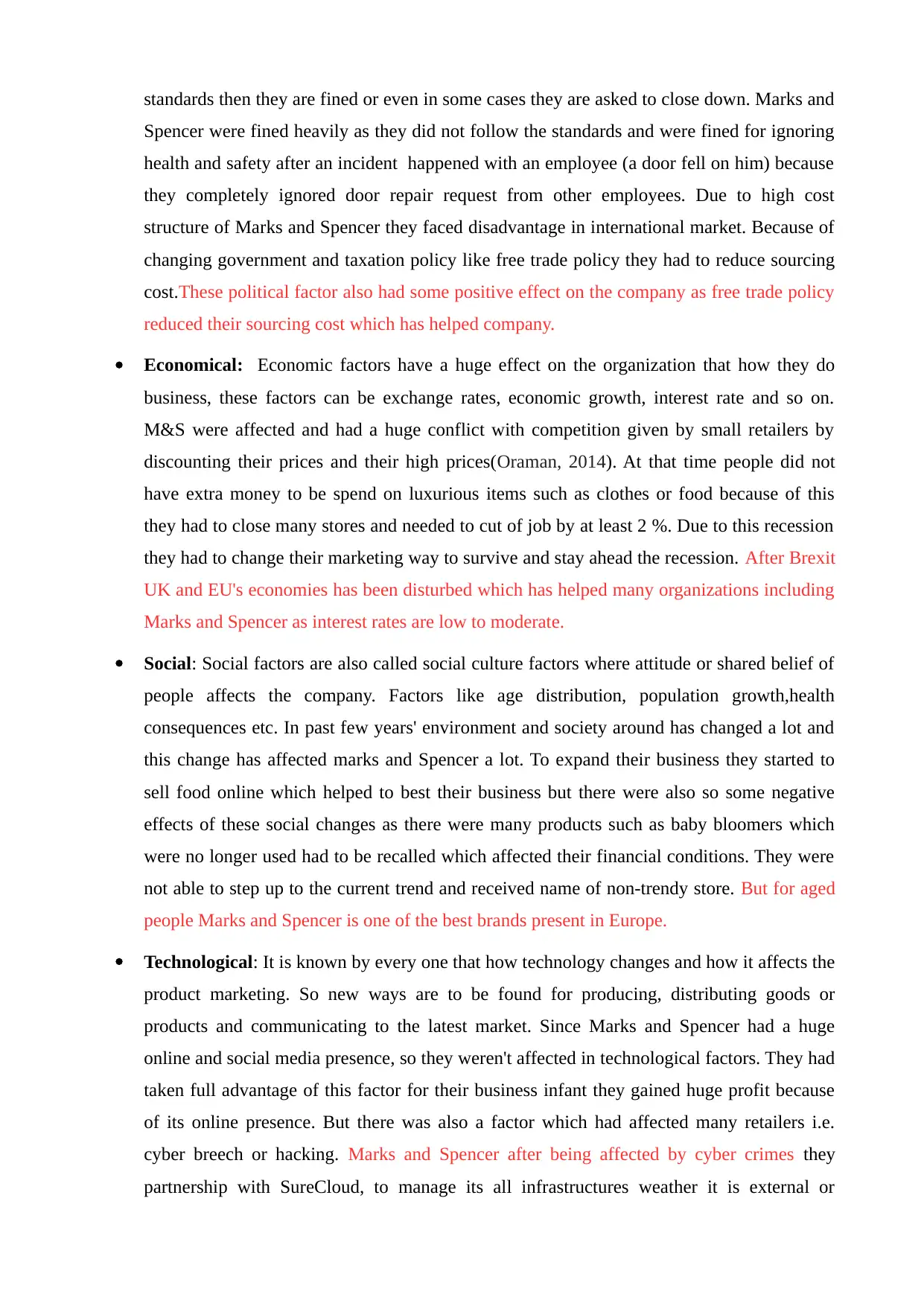
standards then they are fined or even in some cases they are asked to close down. Marks and
Spencer were fined heavily as they did not follow the standards and were fined for ignoring
health and safety after an incident happened with an employee (a door fell on him) because
they completely ignored door repair request from other employees. Due to high cost
structure of Marks and Spencer they faced disadvantage in international market. Because of
changing government and taxation policy like free trade policy they had to reduce sourcing
cost.These political factor also had some positive effect on the company as free trade policy
reduced their sourcing cost which has helped company.
Economical: Economic factors have a huge effect on the organization that how they do
business, these factors can be exchange rates, economic growth, interest rate and so on.
M&S were affected and had a huge conflict with competition given by small retailers by
discounting their prices and their high prices(Oraman, 2014). At that time people did not
have extra money to be spend on luxurious items such as clothes or food because of this
they had to close many stores and needed to cut of job by at least 2 %. Due to this recession
they had to change their marketing way to survive and stay ahead the recession. After Brexit
UK and EU's economies has been disturbed which has helped many organizations including
Marks and Spencer as interest rates are low to moderate.
Social: Social factors are also called social culture factors where attitude or shared belief of
people affects the company. Factors like age distribution, population growth,health
consequences etc. In past few years' environment and society around has changed a lot and
this change has affected marks and Spencer a lot. To expand their business they started to
sell food online which helped to best their business but there were also so some negative
effects of these social changes as there were many products such as baby bloomers which
were no longer used had to be recalled which affected their financial conditions. They were
not able to step up to the current trend and received name of non-trendy store. But for aged
people Marks and Spencer is one of the best brands present in Europe.
Technological: It is known by every one that how technology changes and how it affects the
product marketing. So new ways are to be found for producing, distributing goods or
products and communicating to the latest market. Since Marks and Spencer had a huge
online and social media presence, so they weren't affected in technological factors. They had
taken full advantage of this factor for their business infant they gained huge profit because
of its online presence. But there was also a factor which had affected many retailers i.e.
cyber breech or hacking. Marks and Spencer after being affected by cyber crimes they
partnership with SureCloud, to manage its all infrastructures weather it is external or
Spencer were fined heavily as they did not follow the standards and were fined for ignoring
health and safety after an incident happened with an employee (a door fell on him) because
they completely ignored door repair request from other employees. Due to high cost
structure of Marks and Spencer they faced disadvantage in international market. Because of
changing government and taxation policy like free trade policy they had to reduce sourcing
cost.These political factor also had some positive effect on the company as free trade policy
reduced their sourcing cost which has helped company.
Economical: Economic factors have a huge effect on the organization that how they do
business, these factors can be exchange rates, economic growth, interest rate and so on.
M&S were affected and had a huge conflict with competition given by small retailers by
discounting their prices and their high prices(Oraman, 2014). At that time people did not
have extra money to be spend on luxurious items such as clothes or food because of this
they had to close many stores and needed to cut of job by at least 2 %. Due to this recession
they had to change their marketing way to survive and stay ahead the recession. After Brexit
UK and EU's economies has been disturbed which has helped many organizations including
Marks and Spencer as interest rates are low to moderate.
Social: Social factors are also called social culture factors where attitude or shared belief of
people affects the company. Factors like age distribution, population growth,health
consequences etc. In past few years' environment and society around has changed a lot and
this change has affected marks and Spencer a lot. To expand their business they started to
sell food online which helped to best their business but there were also so some negative
effects of these social changes as there were many products such as baby bloomers which
were no longer used had to be recalled which affected their financial conditions. They were
not able to step up to the current trend and received name of non-trendy store. But for aged
people Marks and Spencer is one of the best brands present in Europe.
Technological: It is known by every one that how technology changes and how it affects the
product marketing. So new ways are to be found for producing, distributing goods or
products and communicating to the latest market. Since Marks and Spencer had a huge
online and social media presence, so they weren't affected in technological factors. They had
taken full advantage of this factor for their business infant they gained huge profit because
of its online presence. But there was also a factor which had affected many retailers i.e.
cyber breech or hacking. Marks and Spencer after being affected by cyber crimes they
partnership with SureCloud, to manage its all infrastructures weather it is external or
Secure Best Marks with AI Grader
Need help grading? Try our AI Grader for instant feedback on your assignments.
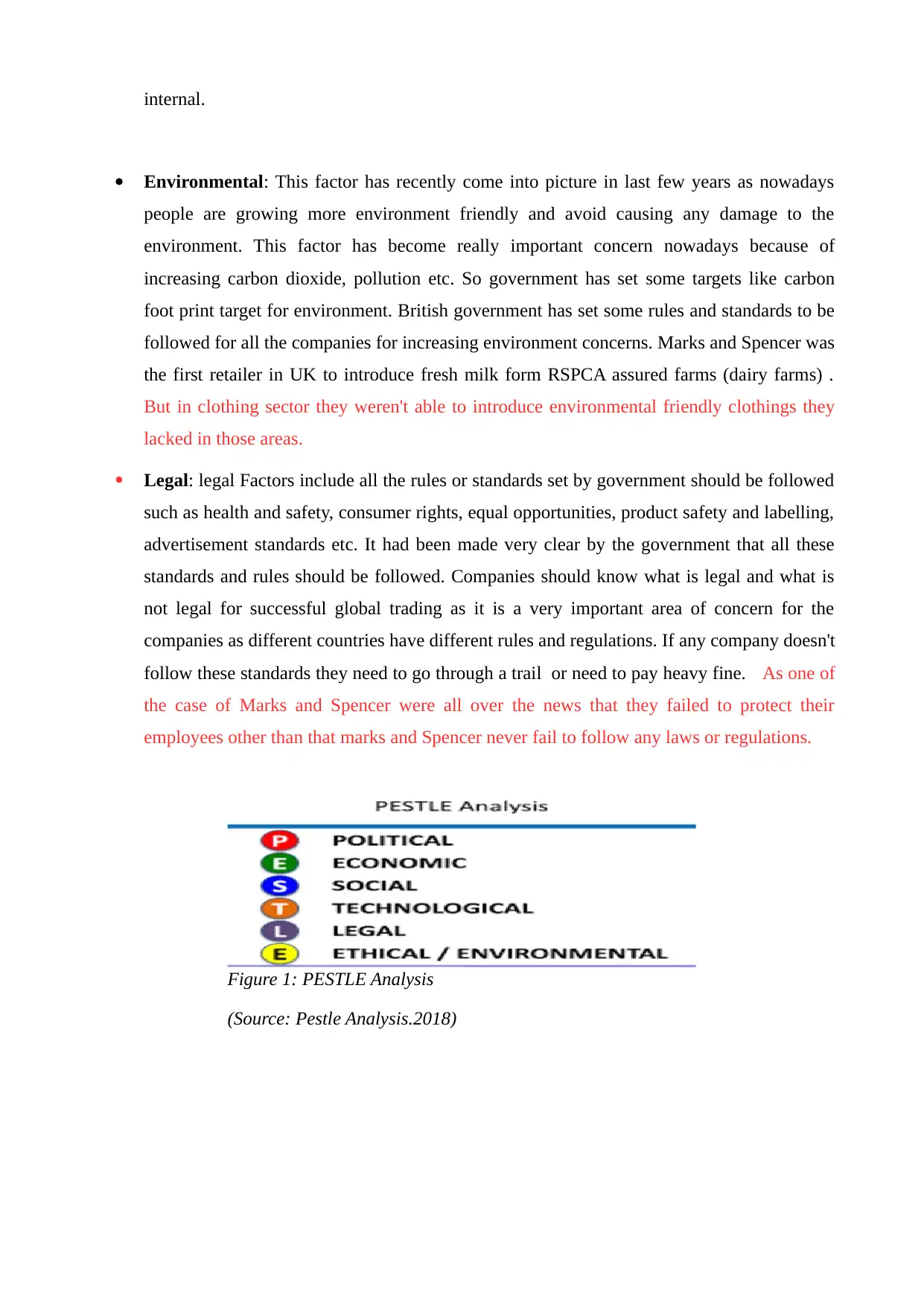
internal.
Environmental: This factor has recently come into picture in last few years as nowadays
people are growing more environment friendly and avoid causing any damage to the
environment. This factor has become really important concern nowadays because of
increasing carbon dioxide, pollution etc. So government has set some targets like carbon
foot print target for environment. British government has set some rules and standards to be
followed for all the companies for increasing environment concerns. Marks and Spencer was
the first retailer in UK to introduce fresh milk form RSPCA assured farms (dairy farms) .
But in clothing sector they weren't able to introduce environmental friendly clothings they
lacked in those areas.
Legal: legal Factors include all the rules or standards set by government should be followed
such as health and safety, consumer rights, equal opportunities, product safety and labelling,
advertisement standards etc. It had been made very clear by the government that all these
standards and rules should be followed. Companies should know what is legal and what is
not legal for successful global trading as it is a very important area of concern for the
companies as different countries have different rules and regulations. If any company doesn't
follow these standards they need to go through a trail or need to pay heavy fine. As one of
the case of Marks and Spencer were all over the news that they failed to protect their
employees other than that marks and Spencer never fail to follow any laws or regulations.
Figure 1: PESTLE Analysis
(Source: Pestle Analysis.2018)
Environmental: This factor has recently come into picture in last few years as nowadays
people are growing more environment friendly and avoid causing any damage to the
environment. This factor has become really important concern nowadays because of
increasing carbon dioxide, pollution etc. So government has set some targets like carbon
foot print target for environment. British government has set some rules and standards to be
followed for all the companies for increasing environment concerns. Marks and Spencer was
the first retailer in UK to introduce fresh milk form RSPCA assured farms (dairy farms) .
But in clothing sector they weren't able to introduce environmental friendly clothings they
lacked in those areas.
Legal: legal Factors include all the rules or standards set by government should be followed
such as health and safety, consumer rights, equal opportunities, product safety and labelling,
advertisement standards etc. It had been made very clear by the government that all these
standards and rules should be followed. Companies should know what is legal and what is
not legal for successful global trading as it is a very important area of concern for the
companies as different countries have different rules and regulations. If any company doesn't
follow these standards they need to go through a trail or need to pay heavy fine. As one of
the case of Marks and Spencer were all over the news that they failed to protect their
employees other than that marks and Spencer never fail to follow any laws or regulations.
Figure 1: PESTLE Analysis
(Source: Pestle Analysis.2018)
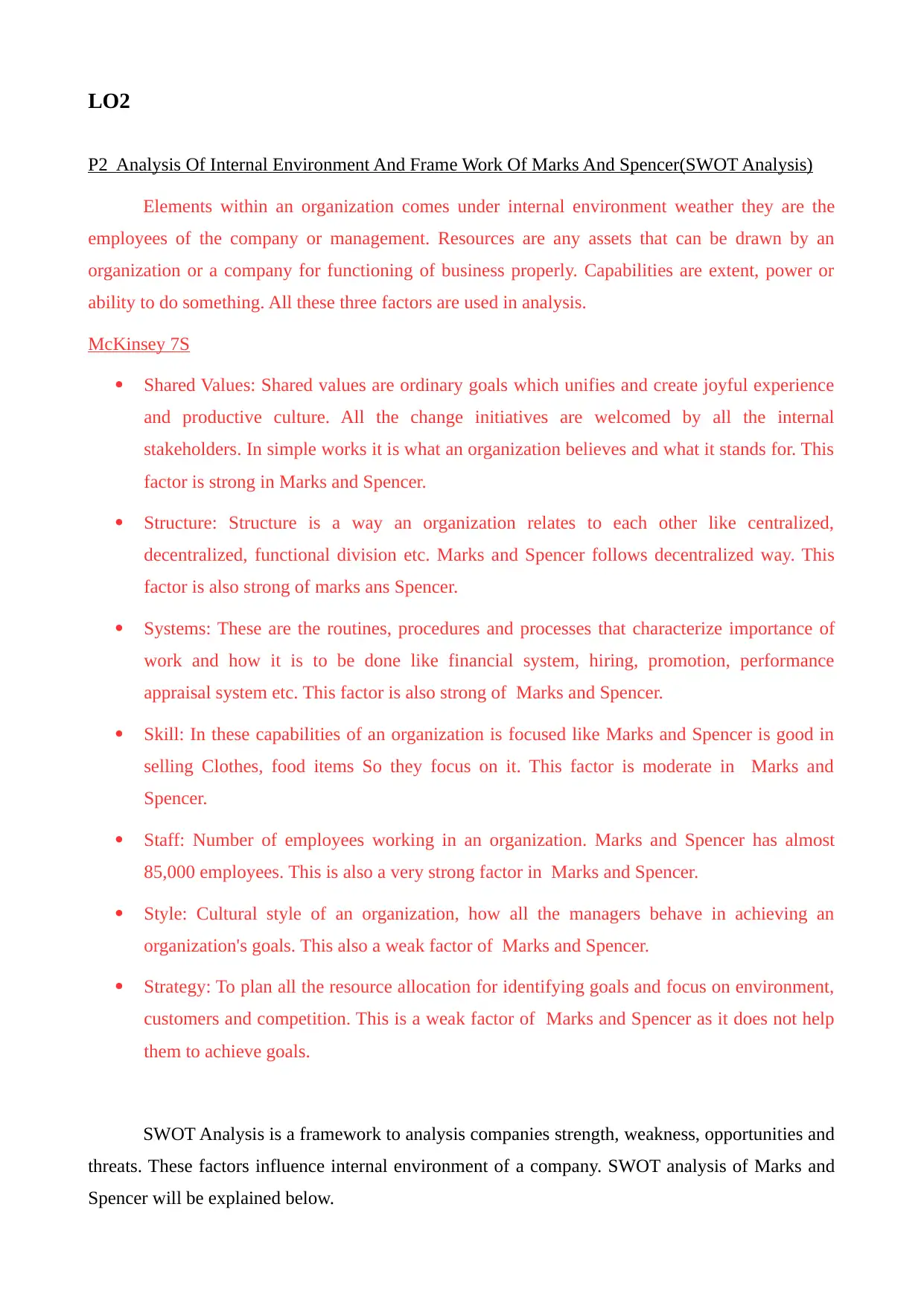
LO2
P2 Analysis Of Internal Environment And Frame Work Of Marks And Spencer(SWOT Analysis)
Elements within an organization comes under internal environment weather they are the
employees of the company or management. Resources are any assets that can be drawn by an
organization or a company for functioning of business properly. Capabilities are extent, power or
ability to do something. All these three factors are used in analysis.
McKinsey 7S
Shared Values: Shared values are ordinary goals which unifies and create joyful experience
and productive culture. All the change initiatives are welcomed by all the internal
stakeholders. In simple works it is what an organization believes and what it stands for. This
factor is strong in Marks and Spencer.
Structure: Structure is a way an organization relates to each other like centralized,
decentralized, functional division etc. Marks and Spencer follows decentralized way. This
factor is also strong of marks ans Spencer.
Systems: These are the routines, procedures and processes that characterize importance of
work and how it is to be done like financial system, hiring, promotion, performance
appraisal system etc. This factor is also strong of Marks and Spencer.
Skill: In these capabilities of an organization is focused like Marks and Spencer is good in
selling Clothes, food items So they focus on it. This factor is moderate in Marks and
Spencer.
Staff: Number of employees working in an organization. Marks and Spencer has almost
85,000 employees. This is also a very strong factor in Marks and Spencer.
Style: Cultural style of an organization, how all the managers behave in achieving an
organization's goals. This also a weak factor of Marks and Spencer.
Strategy: To plan all the resource allocation for identifying goals and focus on environment,
customers and competition. This is a weak factor of Marks and Spencer as it does not help
them to achieve goals.
SWOT Analysis is a framework to analysis companies strength, weakness, opportunities and
threats. These factors influence internal environment of a company. SWOT analysis of Marks and
Spencer will be explained below.
P2 Analysis Of Internal Environment And Frame Work Of Marks And Spencer(SWOT Analysis)
Elements within an organization comes under internal environment weather they are the
employees of the company or management. Resources are any assets that can be drawn by an
organization or a company for functioning of business properly. Capabilities are extent, power or
ability to do something. All these three factors are used in analysis.
McKinsey 7S
Shared Values: Shared values are ordinary goals which unifies and create joyful experience
and productive culture. All the change initiatives are welcomed by all the internal
stakeholders. In simple works it is what an organization believes and what it stands for. This
factor is strong in Marks and Spencer.
Structure: Structure is a way an organization relates to each other like centralized,
decentralized, functional division etc. Marks and Spencer follows decentralized way. This
factor is also strong of marks ans Spencer.
Systems: These are the routines, procedures and processes that characterize importance of
work and how it is to be done like financial system, hiring, promotion, performance
appraisal system etc. This factor is also strong of Marks and Spencer.
Skill: In these capabilities of an organization is focused like Marks and Spencer is good in
selling Clothes, food items So they focus on it. This factor is moderate in Marks and
Spencer.
Staff: Number of employees working in an organization. Marks and Spencer has almost
85,000 employees. This is also a very strong factor in Marks and Spencer.
Style: Cultural style of an organization, how all the managers behave in achieving an
organization's goals. This also a weak factor of Marks and Spencer.
Strategy: To plan all the resource allocation for identifying goals and focus on environment,
customers and competition. This is a weak factor of Marks and Spencer as it does not help
them to achieve goals.
SWOT Analysis is a framework to analysis companies strength, weakness, opportunities and
threats. These factors influence internal environment of a company. SWOT analysis of Marks and
Spencer will be explained below.
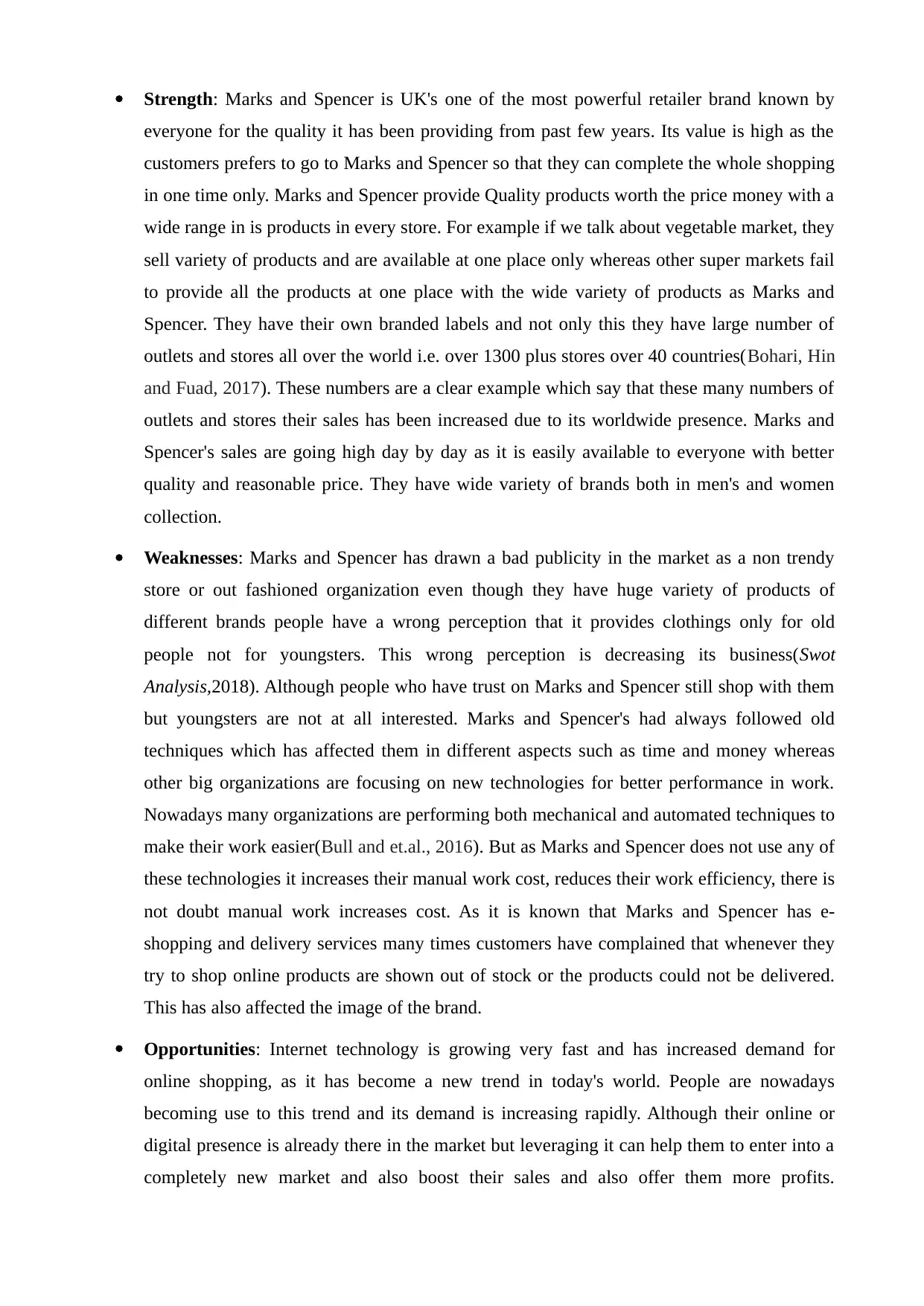
Strength: Marks and Spencer is UK's one of the most powerful retailer brand known by
everyone for the quality it has been providing from past few years. Its value is high as the
customers prefers to go to Marks and Spencer so that they can complete the whole shopping
in one time only. Marks and Spencer provide Quality products worth the price money with a
wide range in is products in every store. For example if we talk about vegetable market, they
sell variety of products and are available at one place only whereas other super markets fail
to provide all the products at one place with the wide variety of products as Marks and
Spencer. They have their own branded labels and not only this they have large number of
outlets and stores all over the world i.e. over 1300 plus stores over 40 countries(Bohari, Hin
and Fuad, 2017). These numbers are a clear example which say that these many numbers of
outlets and stores their sales has been increased due to its worldwide presence. Marks and
Spencer's sales are going high day by day as it is easily available to everyone with better
quality and reasonable price. They have wide variety of brands both in men's and women
collection.
Weaknesses: Marks and Spencer has drawn a bad publicity in the market as a non trendy
store or out fashioned organization even though they have huge variety of products of
different brands people have a wrong perception that it provides clothings only for old
people not for youngsters. This wrong perception is decreasing its business(Swot
Analysis,2018). Although people who have trust on Marks and Spencer still shop with them
but youngsters are not at all interested. Marks and Spencer's had always followed old
techniques which has affected them in different aspects such as time and money whereas
other big organizations are focusing on new technologies for better performance in work.
Nowadays many organizations are performing both mechanical and automated techniques to
make their work easier(Bull and et.al., 2016). But as Marks and Spencer does not use any of
these technologies it increases their manual work cost, reduces their work efficiency, there is
not doubt manual work increases cost. As it is known that Marks and Spencer has e-
shopping and delivery services many times customers have complained that whenever they
try to shop online products are shown out of stock or the products could not be delivered.
This has also affected the image of the brand.
Opportunities: Internet technology is growing very fast and has increased demand for
online shopping, as it has become a new trend in today's world. People are nowadays
becoming use to this trend and its demand is increasing rapidly. Although their online or
digital presence is already there in the market but leveraging it can help them to enter into a
completely new market and also boost their sales and also offer them more profits.
everyone for the quality it has been providing from past few years. Its value is high as the
customers prefers to go to Marks and Spencer so that they can complete the whole shopping
in one time only. Marks and Spencer provide Quality products worth the price money with a
wide range in is products in every store. For example if we talk about vegetable market, they
sell variety of products and are available at one place only whereas other super markets fail
to provide all the products at one place with the wide variety of products as Marks and
Spencer. They have their own branded labels and not only this they have large number of
outlets and stores all over the world i.e. over 1300 plus stores over 40 countries(Bohari, Hin
and Fuad, 2017). These numbers are a clear example which say that these many numbers of
outlets and stores their sales has been increased due to its worldwide presence. Marks and
Spencer's sales are going high day by day as it is easily available to everyone with better
quality and reasonable price. They have wide variety of brands both in men's and women
collection.
Weaknesses: Marks and Spencer has drawn a bad publicity in the market as a non trendy
store or out fashioned organization even though they have huge variety of products of
different brands people have a wrong perception that it provides clothings only for old
people not for youngsters. This wrong perception is decreasing its business(Swot
Analysis,2018). Although people who have trust on Marks and Spencer still shop with them
but youngsters are not at all interested. Marks and Spencer's had always followed old
techniques which has affected them in different aspects such as time and money whereas
other big organizations are focusing on new technologies for better performance in work.
Nowadays many organizations are performing both mechanical and automated techniques to
make their work easier(Bull and et.al., 2016). But as Marks and Spencer does not use any of
these technologies it increases their manual work cost, reduces their work efficiency, there is
not doubt manual work increases cost. As it is known that Marks and Spencer has e-
shopping and delivery services many times customers have complained that whenever they
try to shop online products are shown out of stock or the products could not be delivered.
This has also affected the image of the brand.
Opportunities: Internet technology is growing very fast and has increased demand for
online shopping, as it has become a new trend in today's world. People are nowadays
becoming use to this trend and its demand is increasing rapidly. Although their online or
digital presence is already there in the market but leveraging it can help them to enter into a
completely new market and also boost their sales and also offer them more profits.
Paraphrase This Document
Need a fresh take? Get an instant paraphrase of this document with our AI Paraphraser
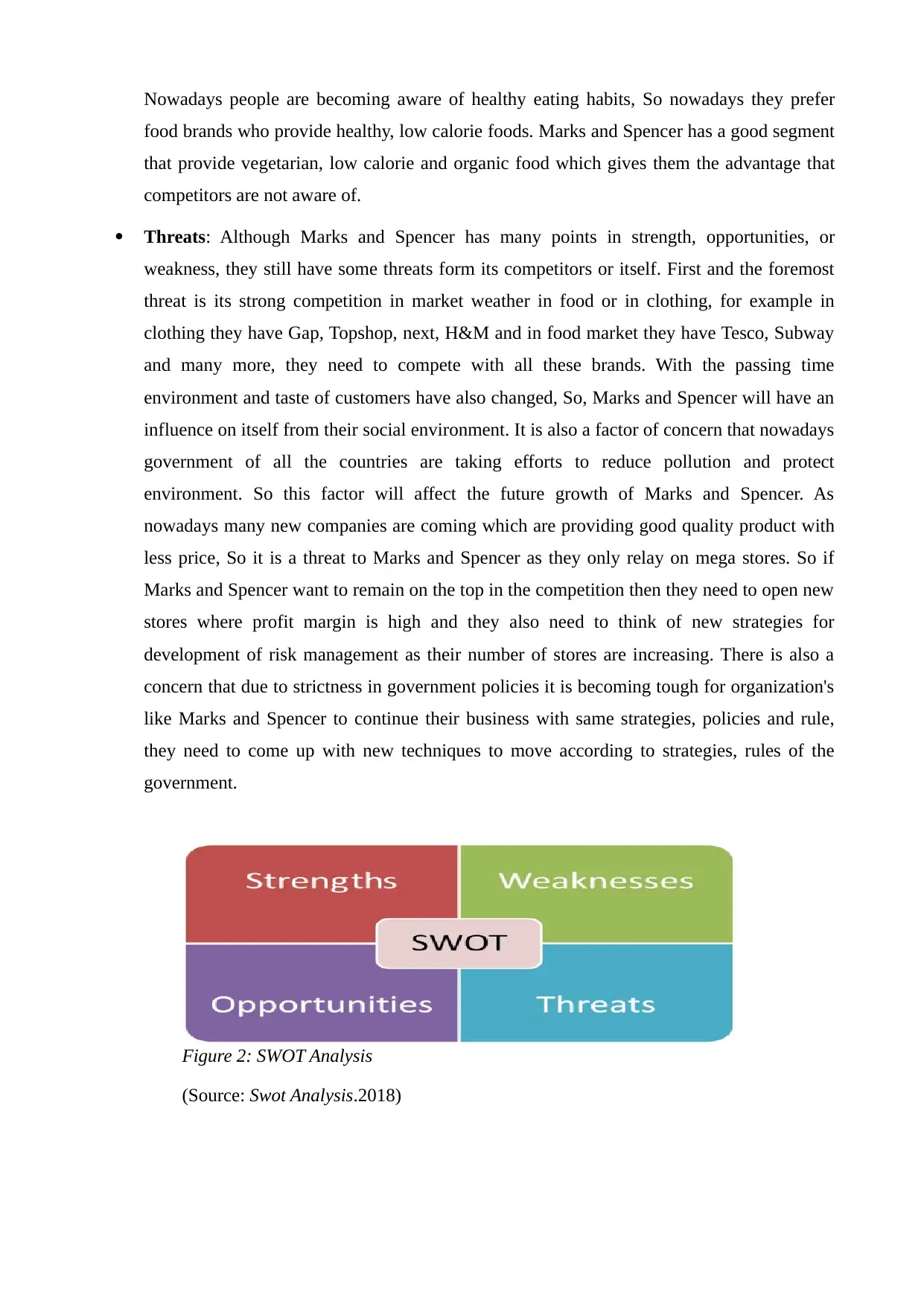
Nowadays people are becoming aware of healthy eating habits, So nowadays they prefer
food brands who provide healthy, low calorie foods. Marks and Spencer has a good segment
that provide vegetarian, low calorie and organic food which gives them the advantage that
competitors are not aware of.
Threats: Although Marks and Spencer has many points in strength, opportunities, or
weakness, they still have some threats form its competitors or itself. First and the foremost
threat is its strong competition in market weather in food or in clothing, for example in
clothing they have Gap, Topshop, next, H&M and in food market they have Tesco, Subway
and many more, they need to compete with all these brands. With the passing time
environment and taste of customers have also changed, So, Marks and Spencer will have an
influence on itself from their social environment. It is also a factor of concern that nowadays
government of all the countries are taking efforts to reduce pollution and protect
environment. So this factor will affect the future growth of Marks and Spencer. As
nowadays many new companies are coming which are providing good quality product with
less price, So it is a threat to Marks and Spencer as they only relay on mega stores. So if
Marks and Spencer want to remain on the top in the competition then they need to open new
stores where profit margin is high and they also need to think of new strategies for
development of risk management as their number of stores are increasing. There is also a
concern that due to strictness in government policies it is becoming tough for organization's
like Marks and Spencer to continue their business with same strategies, policies and rule,
they need to come up with new techniques to move according to strategies, rules of the
government.
Figure 2: SWOT Analysis
(Source: Swot Analysis.2018)
food brands who provide healthy, low calorie foods. Marks and Spencer has a good segment
that provide vegetarian, low calorie and organic food which gives them the advantage that
competitors are not aware of.
Threats: Although Marks and Spencer has many points in strength, opportunities, or
weakness, they still have some threats form its competitors or itself. First and the foremost
threat is its strong competition in market weather in food or in clothing, for example in
clothing they have Gap, Topshop, next, H&M and in food market they have Tesco, Subway
and many more, they need to compete with all these brands. With the passing time
environment and taste of customers have also changed, So, Marks and Spencer will have an
influence on itself from their social environment. It is also a factor of concern that nowadays
government of all the countries are taking efforts to reduce pollution and protect
environment. So this factor will affect the future growth of Marks and Spencer. As
nowadays many new companies are coming which are providing good quality product with
less price, So it is a threat to Marks and Spencer as they only relay on mega stores. So if
Marks and Spencer want to remain on the top in the competition then they need to open new
stores where profit margin is high and they also need to think of new strategies for
development of risk management as their number of stores are increasing. There is also a
concern that due to strictness in government policies it is becoming tough for organization's
like Marks and Spencer to continue their business with same strategies, policies and rule,
they need to come up with new techniques to move according to strategies, rules of the
government.
Figure 2: SWOT Analysis
(Source: Swot Analysis.2018)
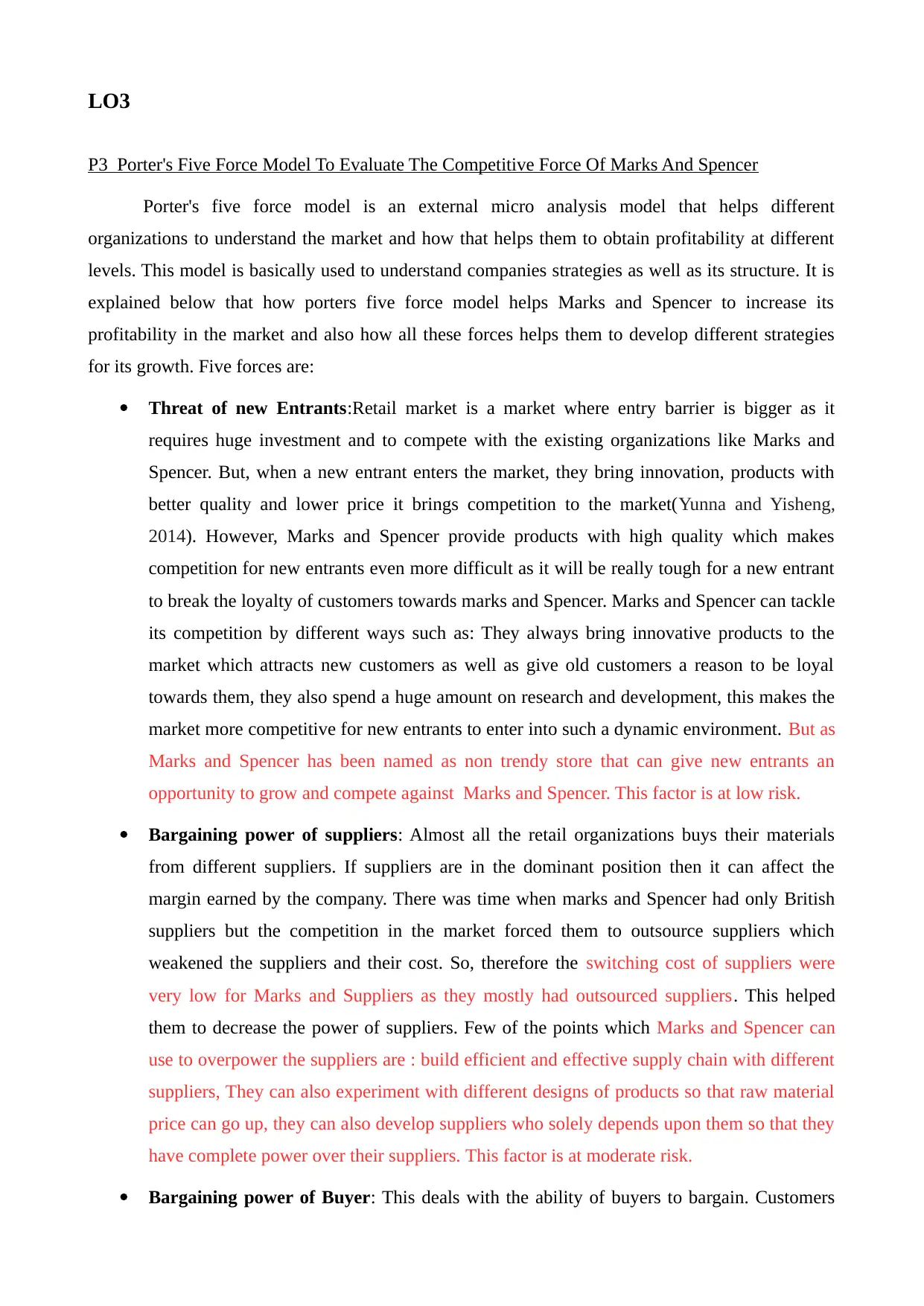
LO3
P3 Porter's Five Force Model To Evaluate The Competitive Force Of Marks And Spencer
Porter's five force model is an external micro analysis model that helps different
organizations to understand the market and how that helps them to obtain profitability at different
levels. This model is basically used to understand companies strategies as well as its structure. It is
explained below that how porters five force model helps Marks and Spencer to increase its
profitability in the market and also how all these forces helps them to develop different strategies
for its growth. Five forces are:
Threat of new Entrants:Retail market is a market where entry barrier is bigger as it
requires huge investment and to compete with the existing organizations like Marks and
Spencer. But, when a new entrant enters the market, they bring innovation, products with
better quality and lower price it brings competition to the market(Yunna and Yisheng,
2014). However, Marks and Spencer provide products with high quality which makes
competition for new entrants even more difficult as it will be really tough for a new entrant
to break the loyalty of customers towards marks and Spencer. Marks and Spencer can tackle
its competition by different ways such as: They always bring innovative products to the
market which attracts new customers as well as give old customers a reason to be loyal
towards them, they also spend a huge amount on research and development, this makes the
market more competitive for new entrants to enter into such a dynamic environment. But as
Marks and Spencer has been named as non trendy store that can give new entrants an
opportunity to grow and compete against Marks and Spencer. This factor is at low risk.
Bargaining power of suppliers: Almost all the retail organizations buys their materials
from different suppliers. If suppliers are in the dominant position then it can affect the
margin earned by the company. There was time when marks and Spencer had only British
suppliers but the competition in the market forced them to outsource suppliers which
weakened the suppliers and their cost. So, therefore the switching cost of suppliers were
very low for Marks and Suppliers as they mostly had outsourced suppliers. This helped
them to decrease the power of suppliers. Few of the points which Marks and Spencer can
use to overpower the suppliers are : build efficient and effective supply chain with different
suppliers, They can also experiment with different designs of products so that raw material
price can go up, they can also develop suppliers who solely depends upon them so that they
have complete power over their suppliers. This factor is at moderate risk.
Bargaining power of Buyer: This deals with the ability of buyers to bargain. Customers
P3 Porter's Five Force Model To Evaluate The Competitive Force Of Marks And Spencer
Porter's five force model is an external micro analysis model that helps different
organizations to understand the market and how that helps them to obtain profitability at different
levels. This model is basically used to understand companies strategies as well as its structure. It is
explained below that how porters five force model helps Marks and Spencer to increase its
profitability in the market and also how all these forces helps them to develop different strategies
for its growth. Five forces are:
Threat of new Entrants:Retail market is a market where entry barrier is bigger as it
requires huge investment and to compete with the existing organizations like Marks and
Spencer. But, when a new entrant enters the market, they bring innovation, products with
better quality and lower price it brings competition to the market(Yunna and Yisheng,
2014). However, Marks and Spencer provide products with high quality which makes
competition for new entrants even more difficult as it will be really tough for a new entrant
to break the loyalty of customers towards marks and Spencer. Marks and Spencer can tackle
its competition by different ways such as: They always bring innovative products to the
market which attracts new customers as well as give old customers a reason to be loyal
towards them, they also spend a huge amount on research and development, this makes the
market more competitive for new entrants to enter into such a dynamic environment. But as
Marks and Spencer has been named as non trendy store that can give new entrants an
opportunity to grow and compete against Marks and Spencer. This factor is at low risk.
Bargaining power of suppliers: Almost all the retail organizations buys their materials
from different suppliers. If suppliers are in the dominant position then it can affect the
margin earned by the company. There was time when marks and Spencer had only British
suppliers but the competition in the market forced them to outsource suppliers which
weakened the suppliers and their cost. So, therefore the switching cost of suppliers were
very low for Marks and Suppliers as they mostly had outsourced suppliers. This helped
them to decrease the power of suppliers. Few of the points which Marks and Spencer can
use to overpower the suppliers are : build efficient and effective supply chain with different
suppliers, They can also experiment with different designs of products so that raw material
price can go up, they can also develop suppliers who solely depends upon them so that they
have complete power over their suppliers. This factor is at moderate risk.
Bargaining power of Buyer: This deals with the ability of buyers to bargain. Customers
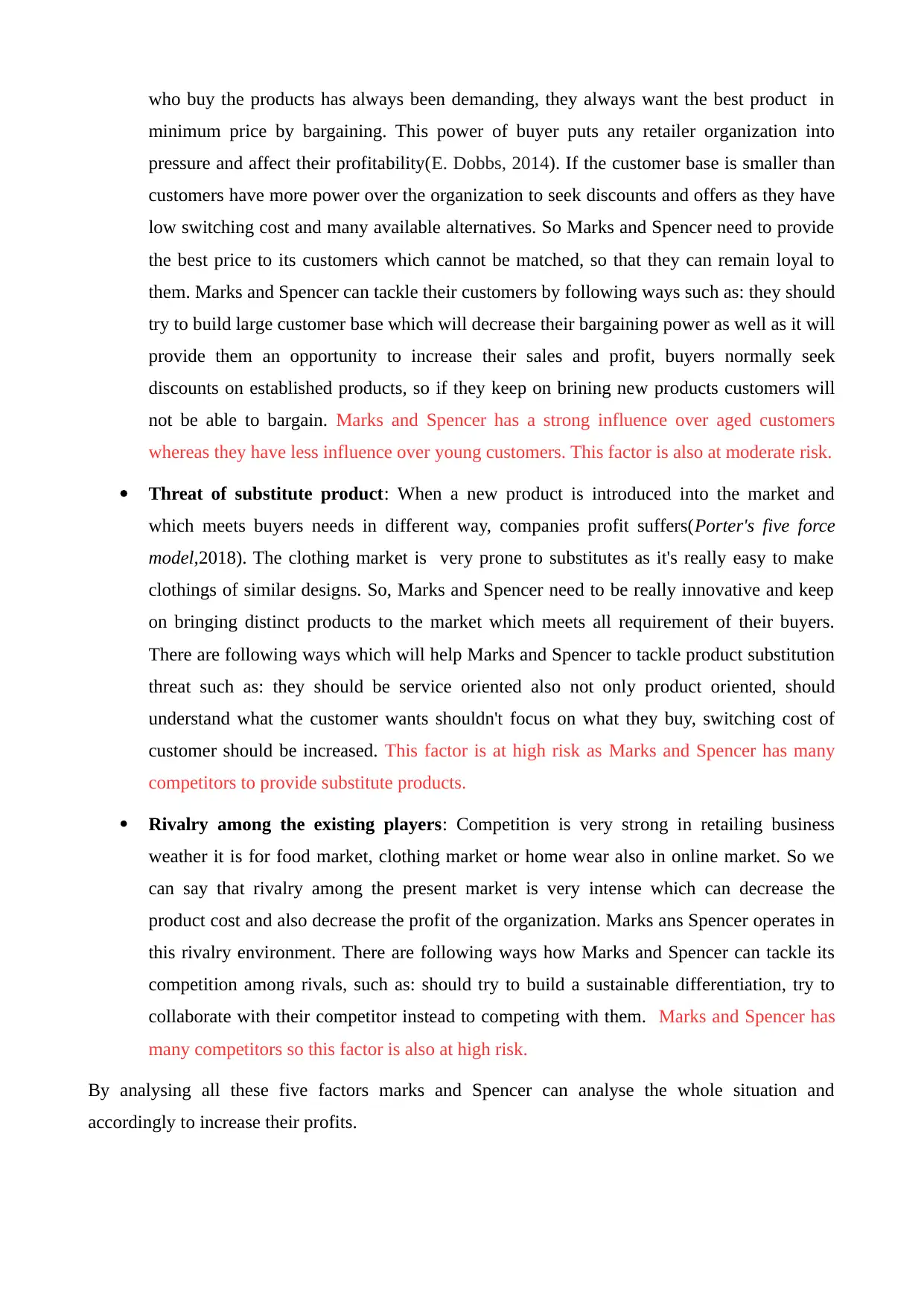
who buy the products has always been demanding, they always want the best product in
minimum price by bargaining. This power of buyer puts any retailer organization into
pressure and affect their profitability(E. Dobbs, 2014). If the customer base is smaller than
customers have more power over the organization to seek discounts and offers as they have
low switching cost and many available alternatives. So Marks and Spencer need to provide
the best price to its customers which cannot be matched, so that they can remain loyal to
them. Marks and Spencer can tackle their customers by following ways such as: they should
try to build large customer base which will decrease their bargaining power as well as it will
provide them an opportunity to increase their sales and profit, buyers normally seek
discounts on established products, so if they keep on brining new products customers will
not be able to bargain. Marks and Spencer has a strong influence over aged customers
whereas they have less influence over young customers. This factor is also at moderate risk.
Threat of substitute product: When a new product is introduced into the market and
which meets buyers needs in different way, companies profit suffers(Porter's five force
model,2018). The clothing market is very prone to substitutes as it's really easy to make
clothings of similar designs. So, Marks and Spencer need to be really innovative and keep
on bringing distinct products to the market which meets all requirement of their buyers.
There are following ways which will help Marks and Spencer to tackle product substitution
threat such as: they should be service oriented also not only product oriented, should
understand what the customer wants shouldn't focus on what they buy, switching cost of
customer should be increased. This factor is at high risk as Marks and Spencer has many
competitors to provide substitute products.
Rivalry among the existing players: Competition is very strong in retailing business
weather it is for food market, clothing market or home wear also in online market. So we
can say that rivalry among the present market is very intense which can decrease the
product cost and also decrease the profit of the organization. Marks ans Spencer operates in
this rivalry environment. There are following ways how Marks and Spencer can tackle its
competition among rivals, such as: should try to build a sustainable differentiation, try to
collaborate with their competitor instead to competing with them. Marks and Spencer has
many competitors so this factor is also at high risk.
By analysing all these five factors marks and Spencer can analyse the whole situation and
accordingly to increase their profits.
minimum price by bargaining. This power of buyer puts any retailer organization into
pressure and affect their profitability(E. Dobbs, 2014). If the customer base is smaller than
customers have more power over the organization to seek discounts and offers as they have
low switching cost and many available alternatives. So Marks and Spencer need to provide
the best price to its customers which cannot be matched, so that they can remain loyal to
them. Marks and Spencer can tackle their customers by following ways such as: they should
try to build large customer base which will decrease their bargaining power as well as it will
provide them an opportunity to increase their sales and profit, buyers normally seek
discounts on established products, so if they keep on brining new products customers will
not be able to bargain. Marks and Spencer has a strong influence over aged customers
whereas they have less influence over young customers. This factor is also at moderate risk.
Threat of substitute product: When a new product is introduced into the market and
which meets buyers needs in different way, companies profit suffers(Porter's five force
model,2018). The clothing market is very prone to substitutes as it's really easy to make
clothings of similar designs. So, Marks and Spencer need to be really innovative and keep
on bringing distinct products to the market which meets all requirement of their buyers.
There are following ways which will help Marks and Spencer to tackle product substitution
threat such as: they should be service oriented also not only product oriented, should
understand what the customer wants shouldn't focus on what they buy, switching cost of
customer should be increased. This factor is at high risk as Marks and Spencer has many
competitors to provide substitute products.
Rivalry among the existing players: Competition is very strong in retailing business
weather it is for food market, clothing market or home wear also in online market. So we
can say that rivalry among the present market is very intense which can decrease the
product cost and also decrease the profit of the organization. Marks ans Spencer operates in
this rivalry environment. There are following ways how Marks and Spencer can tackle its
competition among rivals, such as: should try to build a sustainable differentiation, try to
collaborate with their competitor instead to competing with them. Marks and Spencer has
many competitors so this factor is also at high risk.
By analysing all these five factors marks and Spencer can analyse the whole situation and
accordingly to increase their profits.
Secure Best Marks with AI Grader
Need help grading? Try our AI Grader for instant feedback on your assignments.
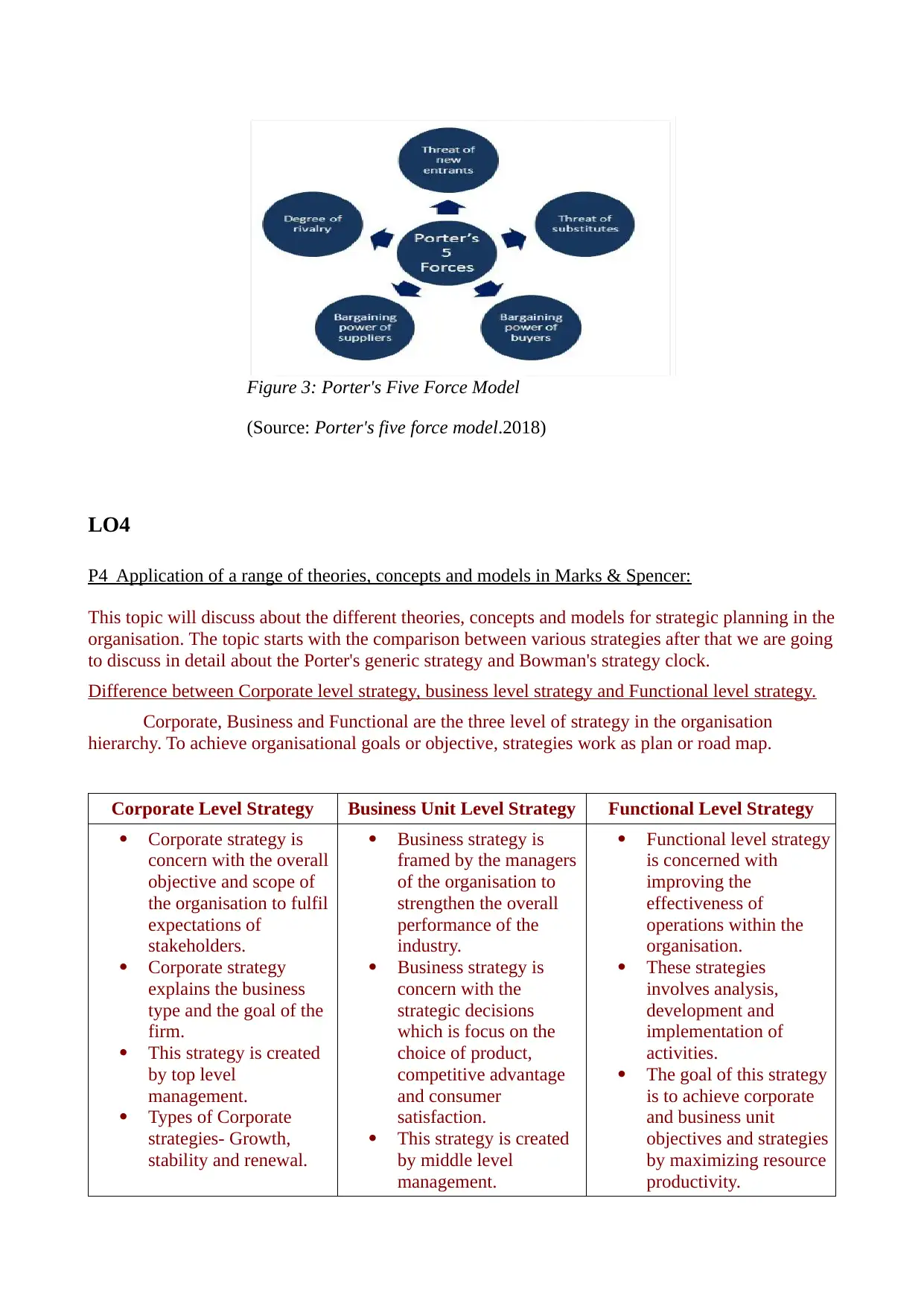
LO4
P4 Application of a range of theories, concepts and models in Marks & Spencer:
This topic will discuss about the different theories, concepts and models for strategic planning in the
organisation. The topic starts with the comparison between various strategies after that we are going
to discuss in detail about the Porter's generic strategy and Bowman's strategy clock.
Difference between Corporate level strategy, business level strategy and Functional level strategy.
Corporate, Business and Functional are the three level of strategy in the organisation
hierarchy. To achieve organisational goals or objective, strategies work as plan or road map.
Corporate Level Strategy Business Unit Level Strategy Functional Level Strategy
Corporate strategy is
concern with the overall
objective and scope of
the organisation to fulfil
expectations of
stakeholders.
Corporate strategy
explains the business
type and the goal of the
firm.
This strategy is created
by top level
management.
Types of Corporate
strategies- Growth,
stability and renewal.
Business strategy is
framed by the managers
of the organisation to
strengthen the overall
performance of the
industry.
Business strategy is
concern with the
strategic decisions
which is focus on the
choice of product,
competitive advantage
and consumer
satisfaction.
This strategy is created
by middle level
management.
Functional level strategy
is concerned with
improving the
effectiveness of
operations within the
organisation.
These strategies
involves analysis,
development and
implementation of
activities.
The goal of this strategy
is to achieve corporate
and business unit
objectives and strategies
by maximizing resource
productivity.
Figure 3: Porter's Five Force Model
(Source: Porter's five force model.2018)
P4 Application of a range of theories, concepts and models in Marks & Spencer:
This topic will discuss about the different theories, concepts and models for strategic planning in the
organisation. The topic starts with the comparison between various strategies after that we are going
to discuss in detail about the Porter's generic strategy and Bowman's strategy clock.
Difference between Corporate level strategy, business level strategy and Functional level strategy.
Corporate, Business and Functional are the three level of strategy in the organisation
hierarchy. To achieve organisational goals or objective, strategies work as plan or road map.
Corporate Level Strategy Business Unit Level Strategy Functional Level Strategy
Corporate strategy is
concern with the overall
objective and scope of
the organisation to fulfil
expectations of
stakeholders.
Corporate strategy
explains the business
type and the goal of the
firm.
This strategy is created
by top level
management.
Types of Corporate
strategies- Growth,
stability and renewal.
Business strategy is
framed by the managers
of the organisation to
strengthen the overall
performance of the
industry.
Business strategy is
concern with the
strategic decisions
which is focus on the
choice of product,
competitive advantage
and consumer
satisfaction.
This strategy is created
by middle level
management.
Functional level strategy
is concerned with
improving the
effectiveness of
operations within the
organisation.
These strategies
involves analysis,
development and
implementation of
activities.
The goal of this strategy
is to achieve corporate
and business unit
objectives and strategies
by maximizing resource
productivity.
Figure 3: Porter's Five Force Model
(Source: Porter's five force model.2018)
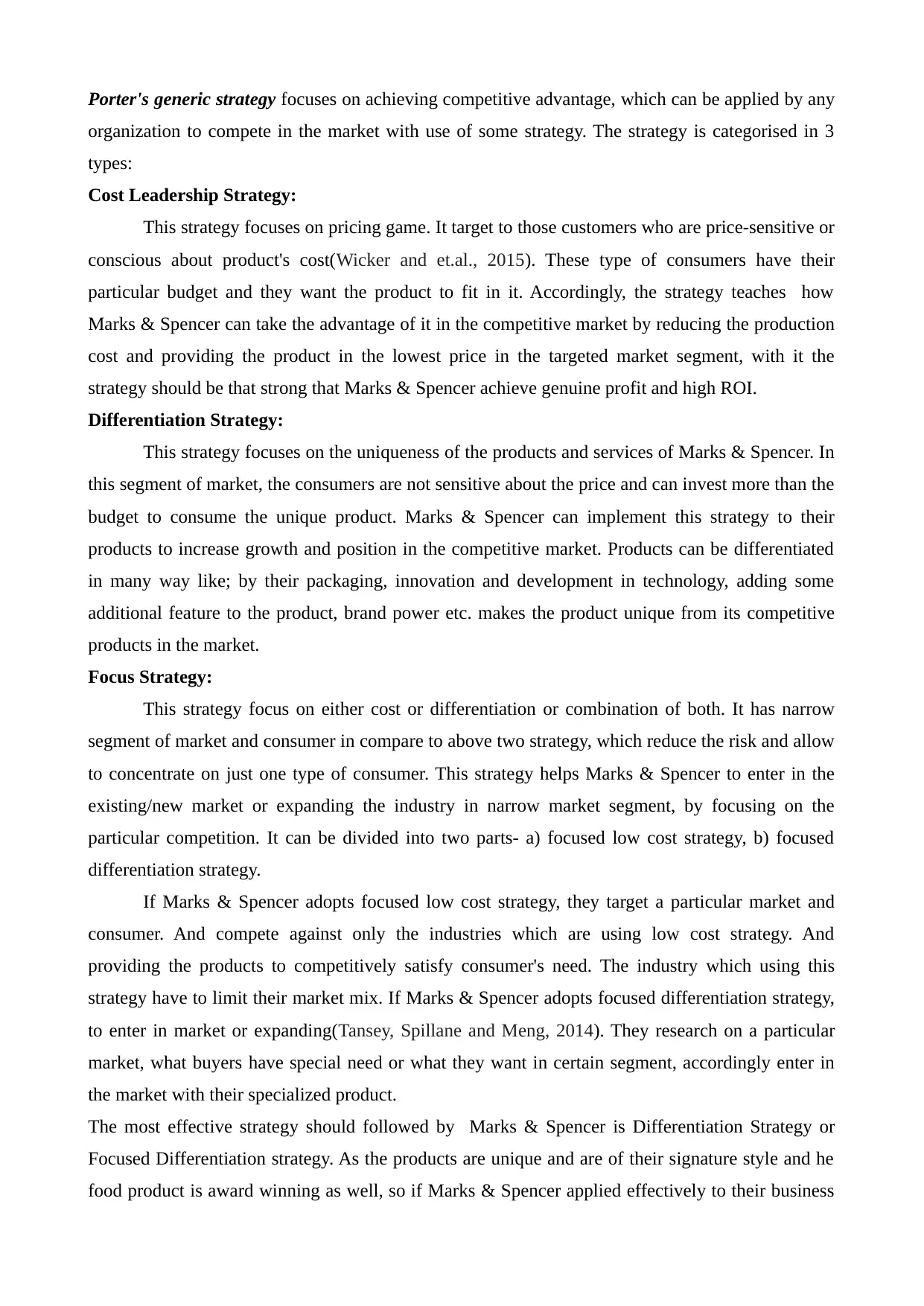
Porter's generic strategy focuses on achieving competitive advantage, which can be applied by any
organization to compete in the market with use of some strategy. The strategy is categorised in 3
types:
Cost Leadership Strategy:
This strategy focuses on pricing game. It target to those customers who are price-sensitive or
conscious about product's cost(Wicker and et.al., 2015). These type of consumers have their
particular budget and they want the product to fit in it. Accordingly, the strategy teaches how
Marks & Spencer can take the advantage of it in the competitive market by reducing the production
cost and providing the product in the lowest price in the targeted market segment, with it the
strategy should be that strong that Marks & Spencer achieve genuine profit and high ROI.
Differentiation Strategy:
This strategy focuses on the uniqueness of the products and services of Marks & Spencer. In
this segment of market, the consumers are not sensitive about the price and can invest more than the
budget to consume the unique product. Marks & Spencer can implement this strategy to their
products to increase growth and position in the competitive market. Products can be differentiated
in many way like; by their packaging, innovation and development in technology, adding some
additional feature to the product, brand power etc. makes the product unique from its competitive
products in the market.
Focus Strategy:
This strategy focus on either cost or differentiation or combination of both. It has narrow
segment of market and consumer in compare to above two strategy, which reduce the risk and allow
to concentrate on just one type of consumer. This strategy helps Marks & Spencer to enter in the
existing/new market or expanding the industry in narrow market segment, by focusing on the
particular competition. It can be divided into two parts- a) focused low cost strategy, b) focused
differentiation strategy.
If Marks & Spencer adopts focused low cost strategy, they target a particular market and
consumer. And compete against only the industries which are using low cost strategy. And
providing the products to competitively satisfy consumer's need. The industry which using this
strategy have to limit their market mix. If Marks & Spencer adopts focused differentiation strategy,
to enter in market or expanding(Tansey, Spillane and Meng, 2014). They research on a particular
market, what buyers have special need or what they want in certain segment, accordingly enter in
the market with their specialized product.
The most effective strategy should followed by Marks & Spencer is Differentiation Strategy or
Focused Differentiation strategy. As the products are unique and are of their signature style and he
food product is award winning as well, so if Marks & Spencer applied effectively to their business
organization to compete in the market with use of some strategy. The strategy is categorised in 3
types:
Cost Leadership Strategy:
This strategy focuses on pricing game. It target to those customers who are price-sensitive or
conscious about product's cost(Wicker and et.al., 2015). These type of consumers have their
particular budget and they want the product to fit in it. Accordingly, the strategy teaches how
Marks & Spencer can take the advantage of it in the competitive market by reducing the production
cost and providing the product in the lowest price in the targeted market segment, with it the
strategy should be that strong that Marks & Spencer achieve genuine profit and high ROI.
Differentiation Strategy:
This strategy focuses on the uniqueness of the products and services of Marks & Spencer. In
this segment of market, the consumers are not sensitive about the price and can invest more than the
budget to consume the unique product. Marks & Spencer can implement this strategy to their
products to increase growth and position in the competitive market. Products can be differentiated
in many way like; by their packaging, innovation and development in technology, adding some
additional feature to the product, brand power etc. makes the product unique from its competitive
products in the market.
Focus Strategy:
This strategy focus on either cost or differentiation or combination of both. It has narrow
segment of market and consumer in compare to above two strategy, which reduce the risk and allow
to concentrate on just one type of consumer. This strategy helps Marks & Spencer to enter in the
existing/new market or expanding the industry in narrow market segment, by focusing on the
particular competition. It can be divided into two parts- a) focused low cost strategy, b) focused
differentiation strategy.
If Marks & Spencer adopts focused low cost strategy, they target a particular market and
consumer. And compete against only the industries which are using low cost strategy. And
providing the products to competitively satisfy consumer's need. The industry which using this
strategy have to limit their market mix. If Marks & Spencer adopts focused differentiation strategy,
to enter in market or expanding(Tansey, Spillane and Meng, 2014). They research on a particular
market, what buyers have special need or what they want in certain segment, accordingly enter in
the market with their specialized product.
The most effective strategy should followed by Marks & Spencer is Differentiation Strategy or
Focused Differentiation strategy. As the products are unique and are of their signature style and he
food product is award winning as well, so if Marks & Spencer applied effectively to their business
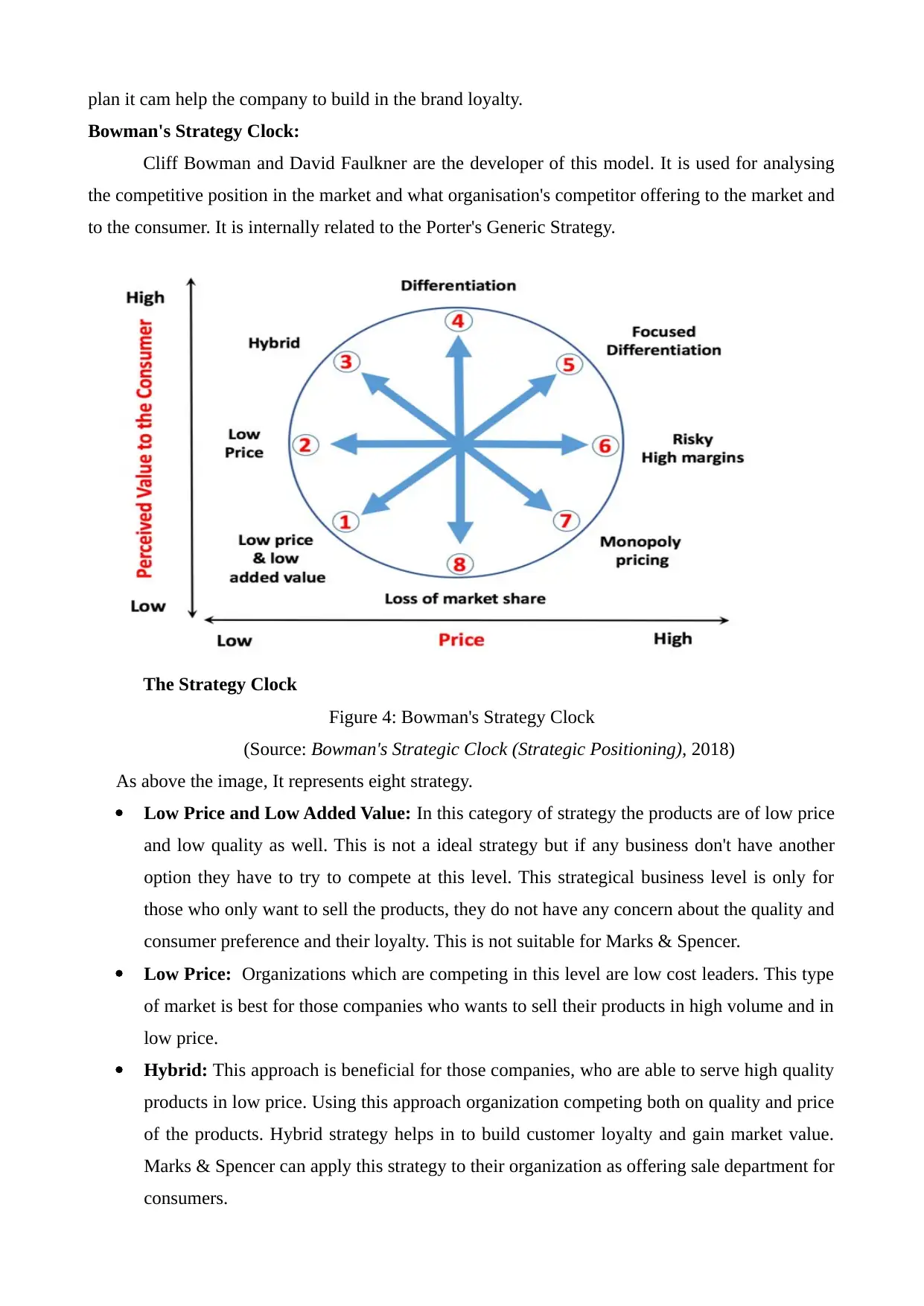
plan it cam help the company to build in the brand loyalty.
Bowman's Strategy Clock:
Cliff Bowman and David Faulkner are the developer of this model. It is used for analysing
the competitive position in the market and what organisation's competitor offering to the market and
to the consumer. It is internally related to the Porter's Generic Strategy.
The Strategy Clock
Figure 4: Bowman's Strategy Clock
(Source: Bowman's Strategic Clock (Strategic Positioning), 2018)
As above the image, It represents eight strategy.
Low Price and Low Added Value: In this category of strategy the products are of low price
and low quality as well. This is not a ideal strategy but if any business don't have another
option they have to try to compete at this level. This strategical business level is only for
those who only want to sell the products, they do not have any concern about the quality and
consumer preference and their loyalty. This is not suitable for Marks & Spencer.
Low Price: Organizations which are competing in this level are low cost leaders. This type
of market is best for those companies who wants to sell their products in high volume and in
low price.
Hybrid: This approach is beneficial for those companies, who are able to serve high quality
products in low price. Using this approach organization competing both on quality and price
of the products. Hybrid strategy helps in to build customer loyalty and gain market value.
Marks & Spencer can apply this strategy to their organization as offering sale department for
consumers.
Bowman's Strategy Clock:
Cliff Bowman and David Faulkner are the developer of this model. It is used for analysing
the competitive position in the market and what organisation's competitor offering to the market and
to the consumer. It is internally related to the Porter's Generic Strategy.
The Strategy Clock
Figure 4: Bowman's Strategy Clock
(Source: Bowman's Strategic Clock (Strategic Positioning), 2018)
As above the image, It represents eight strategy.
Low Price and Low Added Value: In this category of strategy the products are of low price
and low quality as well. This is not a ideal strategy but if any business don't have another
option they have to try to compete at this level. This strategical business level is only for
those who only want to sell the products, they do not have any concern about the quality and
consumer preference and their loyalty. This is not suitable for Marks & Spencer.
Low Price: Organizations which are competing in this level are low cost leaders. This type
of market is best for those companies who wants to sell their products in high volume and in
low price.
Hybrid: This approach is beneficial for those companies, who are able to serve high quality
products in low price. Using this approach organization competing both on quality and price
of the products. Hybrid strategy helps in to build customer loyalty and gain market value.
Marks & Spencer can apply this strategy to their organization as offering sale department for
consumers.
Paraphrase This Document
Need a fresh take? Get an instant paraphrase of this document with our AI Paraphraser
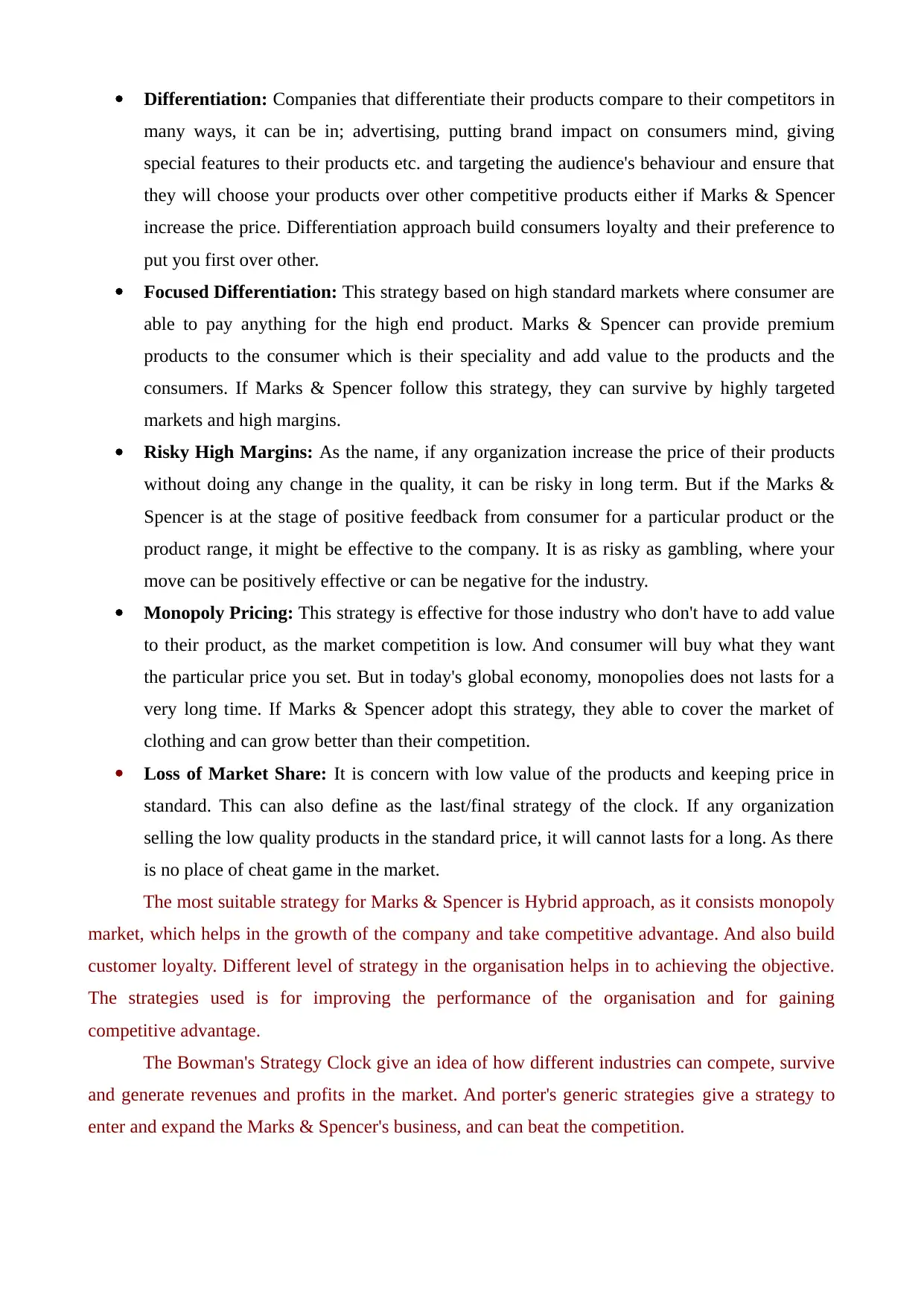
Differentiation: Companies that differentiate their products compare to their competitors in
many ways, it can be in; advertising, putting brand impact on consumers mind, giving
special features to their products etc. and targeting the audience's behaviour and ensure that
they will choose your products over other competitive products either if Marks & Spencer
increase the price. Differentiation approach build consumers loyalty and their preference to
put you first over other.
Focused Differentiation: This strategy based on high standard markets where consumer are
able to pay anything for the high end product. Marks & Spencer can provide premium
products to the consumer which is their speciality and add value to the products and the
consumers. If Marks & Spencer follow this strategy, they can survive by highly targeted
markets and high margins.
Risky High Margins: As the name, if any organization increase the price of their products
without doing any change in the quality, it can be risky in long term. But if the Marks &
Spencer is at the stage of positive feedback from consumer for a particular product or the
product range, it might be effective to the company. It is as risky as gambling, where your
move can be positively effective or can be negative for the industry.
Monopoly Pricing: This strategy is effective for those industry who don't have to add value
to their product, as the market competition is low. And consumer will buy what they want
the particular price you set. But in today's global economy, monopolies does not lasts for a
very long time. If Marks & Spencer adopt this strategy, they able to cover the market of
clothing and can grow better than their competition.
Loss of Market Share: It is concern with low value of the products and keeping price in
standard. This can also define as the last/final strategy of the clock. If any organization
selling the low quality products in the standard price, it will cannot lasts for a long. As there
is no place of cheat game in the market.
The most suitable strategy for Marks & Spencer is Hybrid approach, as it consists monopoly
market, which helps in the growth of the company and take competitive advantage. And also build
customer loyalty. Different level of strategy in the organisation helps in to achieving the objective.
The strategies used is for improving the performance of the organisation and for gaining
competitive advantage.
The Bowman's Strategy Clock give an idea of how different industries can compete, survive
and generate revenues and profits in the market. And porter's generic strategies give a strategy to
enter and expand the Marks & Spencer's business, and can beat the competition.
many ways, it can be in; advertising, putting brand impact on consumers mind, giving
special features to their products etc. and targeting the audience's behaviour and ensure that
they will choose your products over other competitive products either if Marks & Spencer
increase the price. Differentiation approach build consumers loyalty and their preference to
put you first over other.
Focused Differentiation: This strategy based on high standard markets where consumer are
able to pay anything for the high end product. Marks & Spencer can provide premium
products to the consumer which is their speciality and add value to the products and the
consumers. If Marks & Spencer follow this strategy, they can survive by highly targeted
markets and high margins.
Risky High Margins: As the name, if any organization increase the price of their products
without doing any change in the quality, it can be risky in long term. But if the Marks &
Spencer is at the stage of positive feedback from consumer for a particular product or the
product range, it might be effective to the company. It is as risky as gambling, where your
move can be positively effective or can be negative for the industry.
Monopoly Pricing: This strategy is effective for those industry who don't have to add value
to their product, as the market competition is low. And consumer will buy what they want
the particular price you set. But in today's global economy, monopolies does not lasts for a
very long time. If Marks & Spencer adopt this strategy, they able to cover the market of
clothing and can grow better than their competition.
Loss of Market Share: It is concern with low value of the products and keeping price in
standard. This can also define as the last/final strategy of the clock. If any organization
selling the low quality products in the standard price, it will cannot lasts for a long. As there
is no place of cheat game in the market.
The most suitable strategy for Marks & Spencer is Hybrid approach, as it consists monopoly
market, which helps in the growth of the company and take competitive advantage. And also build
customer loyalty. Different level of strategy in the organisation helps in to achieving the objective.
The strategies used is for improving the performance of the organisation and for gaining
competitive advantage.
The Bowman's Strategy Clock give an idea of how different industries can compete, survive
and generate revenues and profits in the market. And porter's generic strategies give a strategy to
enter and expand the Marks & Spencer's business, and can beat the competition.
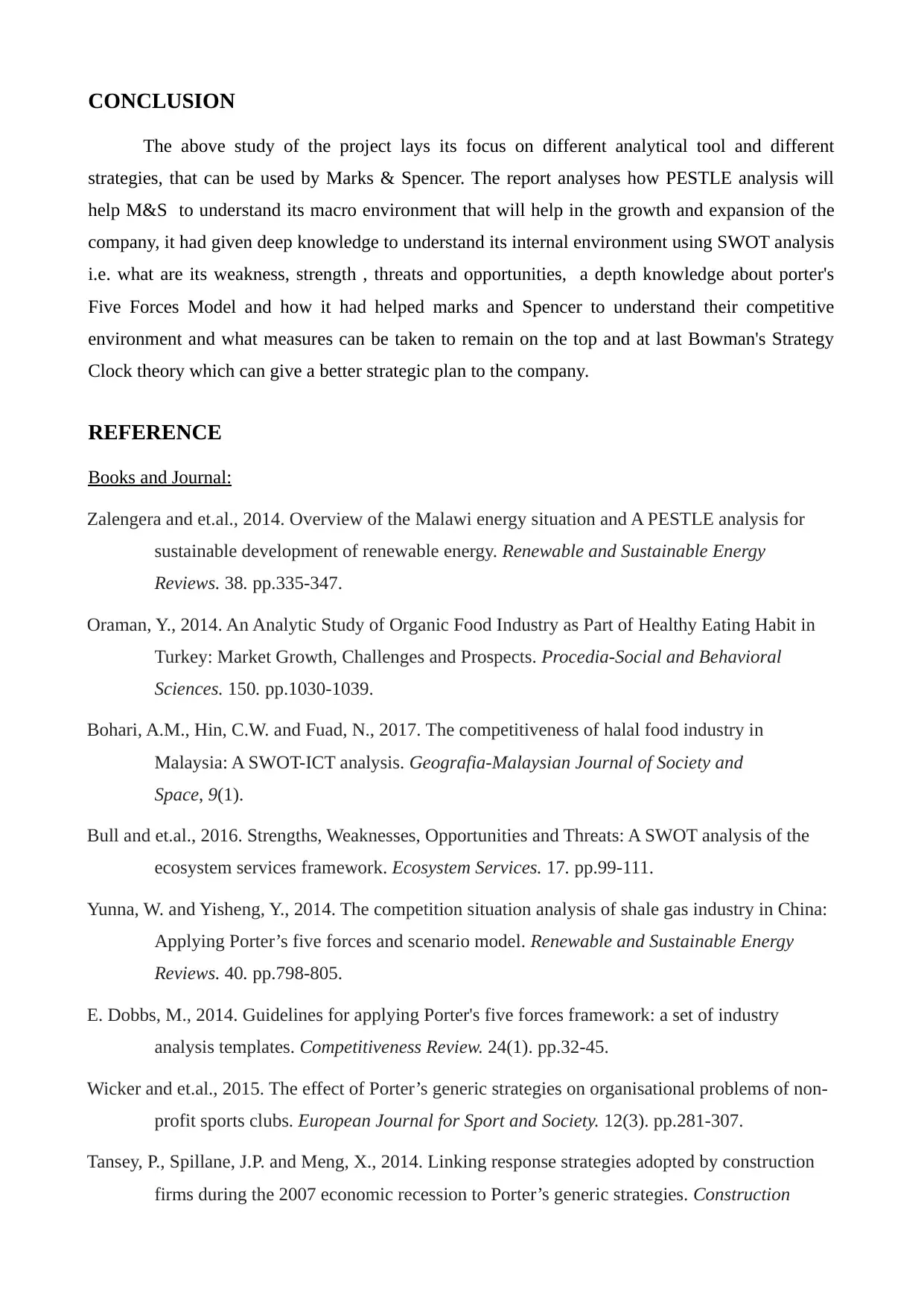
CONCLUSION
The above study of the project lays its focus on different analytical tool and different
strategies, that can be used by Marks & Spencer. The report analyses how PESTLE analysis will
help M&S to understand its macro environment that will help in the growth and expansion of the
company, it had given deep knowledge to understand its internal environment using SWOT analysis
i.e. what are its weakness, strength , threats and opportunities, a depth knowledge about porter's
Five Forces Model and how it had helped marks and Spencer to understand their competitive
environment and what measures can be taken to remain on the top and at last Bowman's Strategy
Clock theory which can give a better strategic plan to the company.
REFERENCE
Books and Journal:
Zalengera and et.al., 2014. Overview of the Malawi energy situation and A PESTLE analysis for
sustainable development of renewable energy. Renewable and Sustainable Energy
Reviews. 38. pp.335-347.
Oraman, Y., 2014. An Analytic Study of Organic Food Industry as Part of Healthy Eating Habit in
Turkey: Market Growth, Challenges and Prospects. Procedia-Social and Behavioral
Sciences. 150. pp.1030-1039.
Bohari, A.M., Hin, C.W. and Fuad, N., 2017. The competitiveness of halal food industry in
Malaysia: A SWOT-ICT analysis. Geografia-Malaysian Journal of Society and
Space, 9(1).
Bull and et.al., 2016. Strengths, Weaknesses, Opportunities and Threats: A SWOT analysis of the
ecosystem services framework. Ecosystem Services. 17. pp.99-111.
Yunna, W. and Yisheng, Y., 2014. The competition situation analysis of shale gas industry in China:
Applying Porter’s five forces and scenario model. Renewable and Sustainable Energy
Reviews. 40. pp.798-805.
E. Dobbs, M., 2014. Guidelines for applying Porter's five forces framework: a set of industry
analysis templates. Competitiveness Review. 24(1). pp.32-45.
Wicker and et.al., 2015. The effect of Porter’s generic strategies on organisational problems of non-
profit sports clubs. European Journal for Sport and Society. 12(3). pp.281-307.
Tansey, P., Spillane, J.P. and Meng, X., 2014. Linking response strategies adopted by construction
firms during the 2007 economic recession to Porter’s generic strategies. Construction
The above study of the project lays its focus on different analytical tool and different
strategies, that can be used by Marks & Spencer. The report analyses how PESTLE analysis will
help M&S to understand its macro environment that will help in the growth and expansion of the
company, it had given deep knowledge to understand its internal environment using SWOT analysis
i.e. what are its weakness, strength , threats and opportunities, a depth knowledge about porter's
Five Forces Model and how it had helped marks and Spencer to understand their competitive
environment and what measures can be taken to remain on the top and at last Bowman's Strategy
Clock theory which can give a better strategic plan to the company.
REFERENCE
Books and Journal:
Zalengera and et.al., 2014. Overview of the Malawi energy situation and A PESTLE analysis for
sustainable development of renewable energy. Renewable and Sustainable Energy
Reviews. 38. pp.335-347.
Oraman, Y., 2014. An Analytic Study of Organic Food Industry as Part of Healthy Eating Habit in
Turkey: Market Growth, Challenges and Prospects. Procedia-Social and Behavioral
Sciences. 150. pp.1030-1039.
Bohari, A.M., Hin, C.W. and Fuad, N., 2017. The competitiveness of halal food industry in
Malaysia: A SWOT-ICT analysis. Geografia-Malaysian Journal of Society and
Space, 9(1).
Bull and et.al., 2016. Strengths, Weaknesses, Opportunities and Threats: A SWOT analysis of the
ecosystem services framework. Ecosystem Services. 17. pp.99-111.
Yunna, W. and Yisheng, Y., 2014. The competition situation analysis of shale gas industry in China:
Applying Porter’s five forces and scenario model. Renewable and Sustainable Energy
Reviews. 40. pp.798-805.
E. Dobbs, M., 2014. Guidelines for applying Porter's five forces framework: a set of industry
analysis templates. Competitiveness Review. 24(1). pp.32-45.
Wicker and et.al., 2015. The effect of Porter’s generic strategies on organisational problems of non-
profit sports clubs. European Journal for Sport and Society. 12(3). pp.281-307.
Tansey, P., Spillane, J.P. and Meng, X., 2014. Linking response strategies adopted by construction
firms during the 2007 economic recession to Porter’s generic strategies. Construction
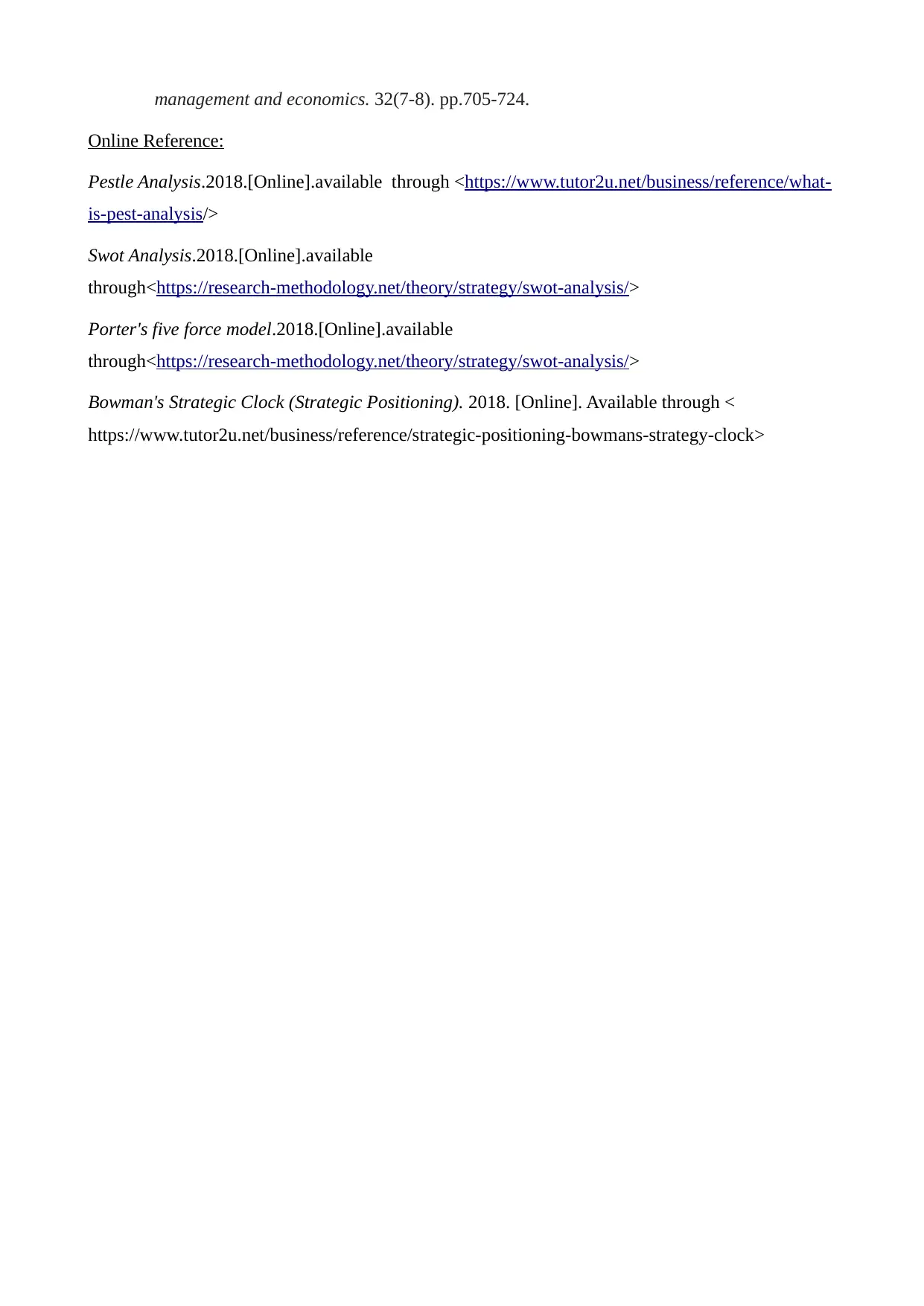
management and economics. 32(7-8). pp.705-724.
Online Reference:
Pestle Analysis.2018.[Online].available through <https://www.tutor2u.net/business/reference/what-
is-pest-analysis/>
Swot Analysis.2018.[Online].available
through<https://research-methodology.net/theory/strategy/swot-analysis/>
Porter's five force model.2018.[Online].available
through<https://research-methodology.net/theory/strategy/swot-analysis/>
Bowman's Strategic Clock (Strategic Positioning). 2018. [Online]. Available through <
https://www.tutor2u.net/business/reference/strategic-positioning-bowmans-strategy-clock>
Online Reference:
Pestle Analysis.2018.[Online].available through <https://www.tutor2u.net/business/reference/what-
is-pest-analysis/>
Swot Analysis.2018.[Online].available
through<https://research-methodology.net/theory/strategy/swot-analysis/>
Porter's five force model.2018.[Online].available
through<https://research-methodology.net/theory/strategy/swot-analysis/>
Bowman's Strategic Clock (Strategic Positioning). 2018. [Online]. Available through <
https://www.tutor2u.net/business/reference/strategic-positioning-bowmans-strategy-clock>
1 out of 16
Related Documents
Your All-in-One AI-Powered Toolkit for Academic Success.
+13062052269
info@desklib.com
Available 24*7 on WhatsApp / Email
![[object Object]](/_next/static/media/star-bottom.7253800d.svg)
Unlock your academic potential
© 2024 | Zucol Services PVT LTD | All rights reserved.




